-
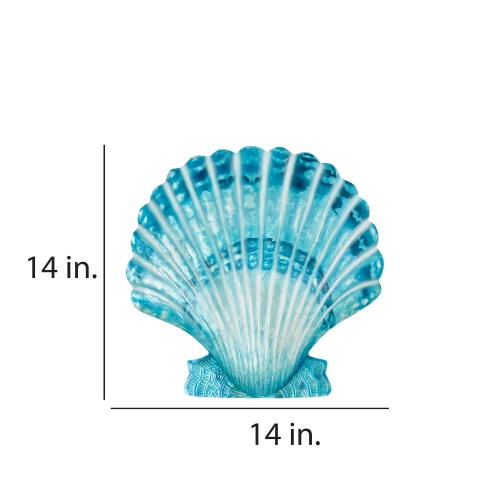
 The design is based on the shape of the Senatorial scallop found in the tropical waters of the pacific. Like the rings of a tree, one can determine the age of a scallop my counting the rings on its shell. Each ring represents one year of growth. The artist using this feature to add beautiful detail along with a deep aqua color to reflect its ocean habitat. Real capiz oyster shell adorns the exterior giving this piece a shimmer as if light were bouncing off its shell from under water. The basic frame of this piece is created using tin, which is powder coated with a black finish. The frame is reinforced using tin wire along the inner edge. The front of the body is adorned with capiz. Capiz is an oyster shell and the primary purpose of the oyster is as a source of food. However, the by-product, the shell, can be used for decoration. Due to it being a natural material, the natural colors of the capiz may come through as tans and browns underneath the hand-painted surface.
The design is based on the shape of the Senatorial scallop found in the tropical waters of the pacific. Like the rings of a tree, one can determine the age of a scallop my counting the rings on its shell. Each ring represents one year of growth. The artist using this feature to add beautiful detail along with a deep aqua color to reflect its ocean habitat. Real capiz oyster shell adorns the exterior giving this piece a shimmer as if light were bouncing off its shell from under water. The basic frame of this piece is created using tin, which is powder coated with a black finish. The frame is reinforced using tin wire along the inner edge. The front of the body is adorned with capiz. Capiz is an oyster shell and the primary purpose of the oyster is as a source of food. However, the by-product, the shell, can be used for decoration. Due to it being a natural material, the natural colors of the capiz may come through as tans and browns underneath the hand-painted surface. -
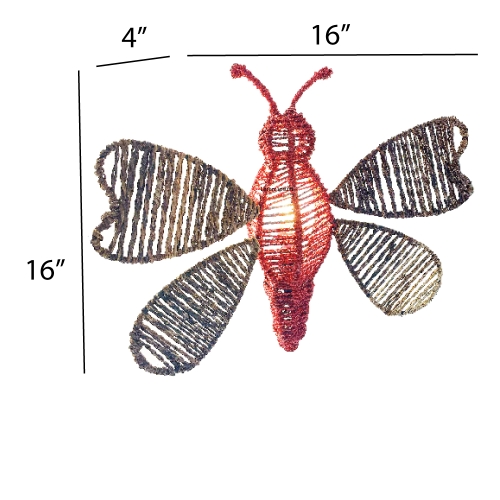
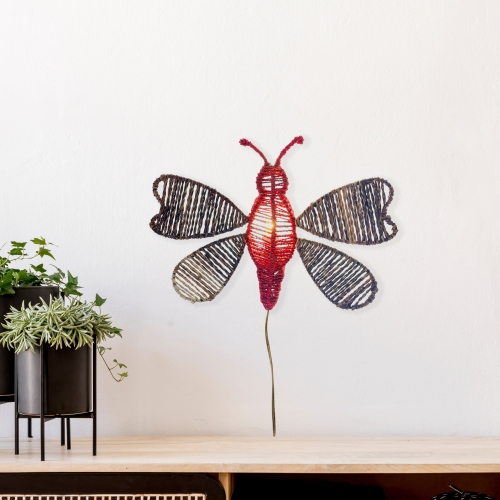 This butterfly is large and bold with its striking bright red body. But this butterfly isn't mono-colored. Instead, the artist uses natural earth tones within its wings to create contrast and warmth. This piece adds fun on its own but can have even larger impact if placed in a group with a few friends! The butterfly's wings are comprised of natural abaca rope handwoven into a wrought iron frame. The head and body is made of abaca twine, stained, and then handwoven into the same wrought iron fame, emphasizing the contrast between the body and wings. Abaca is a fiber of a plant that is related to the banana plant. It bears no fruit, but it can continuously grow from the same roots similar to native grasses. The open weaving allows for ambient light to show through providing functional light. Also included is a plug with an inline switch for easy use.
This butterfly is large and bold with its striking bright red body. But this butterfly isn't mono-colored. Instead, the artist uses natural earth tones within its wings to create contrast and warmth. This piece adds fun on its own but can have even larger impact if placed in a group with a few friends! The butterfly's wings are comprised of natural abaca rope handwoven into a wrought iron frame. The head and body is made of abaca twine, stained, and then handwoven into the same wrought iron fame, emphasizing the contrast between the body and wings. Abaca is a fiber of a plant that is related to the banana plant. It bears no fruit, but it can continuously grow from the same roots similar to native grasses. The open weaving allows for ambient light to show through providing functional light. Also included is a plug with an inline switch for easy use. -
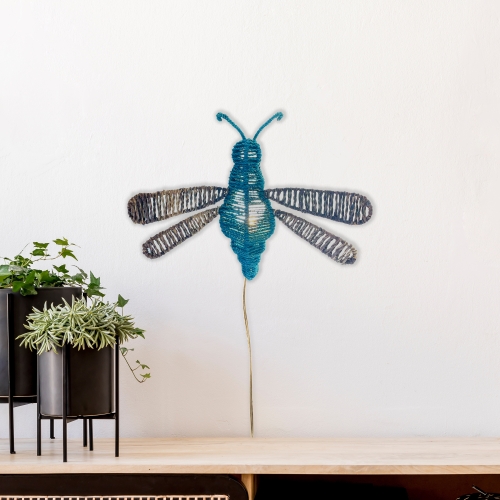
 Reflecting the natural aquas and blues of the nearly translucent dragonfly, the artist uses a base of sea blue dyed abaca weave to embody the almost ephemeral structure. The wings feature a natural abaca rope mimicking the texture of a dragonfly's organic wing structure. This piece adds fun on its own but can have even larger impact if placed in a group with a few friends! The dragonfly's wings are comprised of natural abaca rope handwoven into a wrought iron frame. The head and body is made of abaca twine, stained, and then handwoven into the same wrought iron fame, emphasizing the contrast between the body and wings. Abaca is a fiber of a plant that is related to the banana plant. It bears no fruit, but it can continuously grow from the same roots similar to native grasses. The open weaving allows for ambient light to show through providing functional light. Also included is a plug with an inline switch for easy use.
Reflecting the natural aquas and blues of the nearly translucent dragonfly, the artist uses a base of sea blue dyed abaca weave to embody the almost ephemeral structure. The wings feature a natural abaca rope mimicking the texture of a dragonfly's organic wing structure. This piece adds fun on its own but can have even larger impact if placed in a group with a few friends! The dragonfly's wings are comprised of natural abaca rope handwoven into a wrought iron frame. The head and body is made of abaca twine, stained, and then handwoven into the same wrought iron fame, emphasizing the contrast between the body and wings. Abaca is a fiber of a plant that is related to the banana plant. It bears no fruit, but it can continuously grow from the same roots similar to native grasses. The open weaving allows for ambient light to show through providing functional light. Also included is a plug with an inline switch for easy use. -
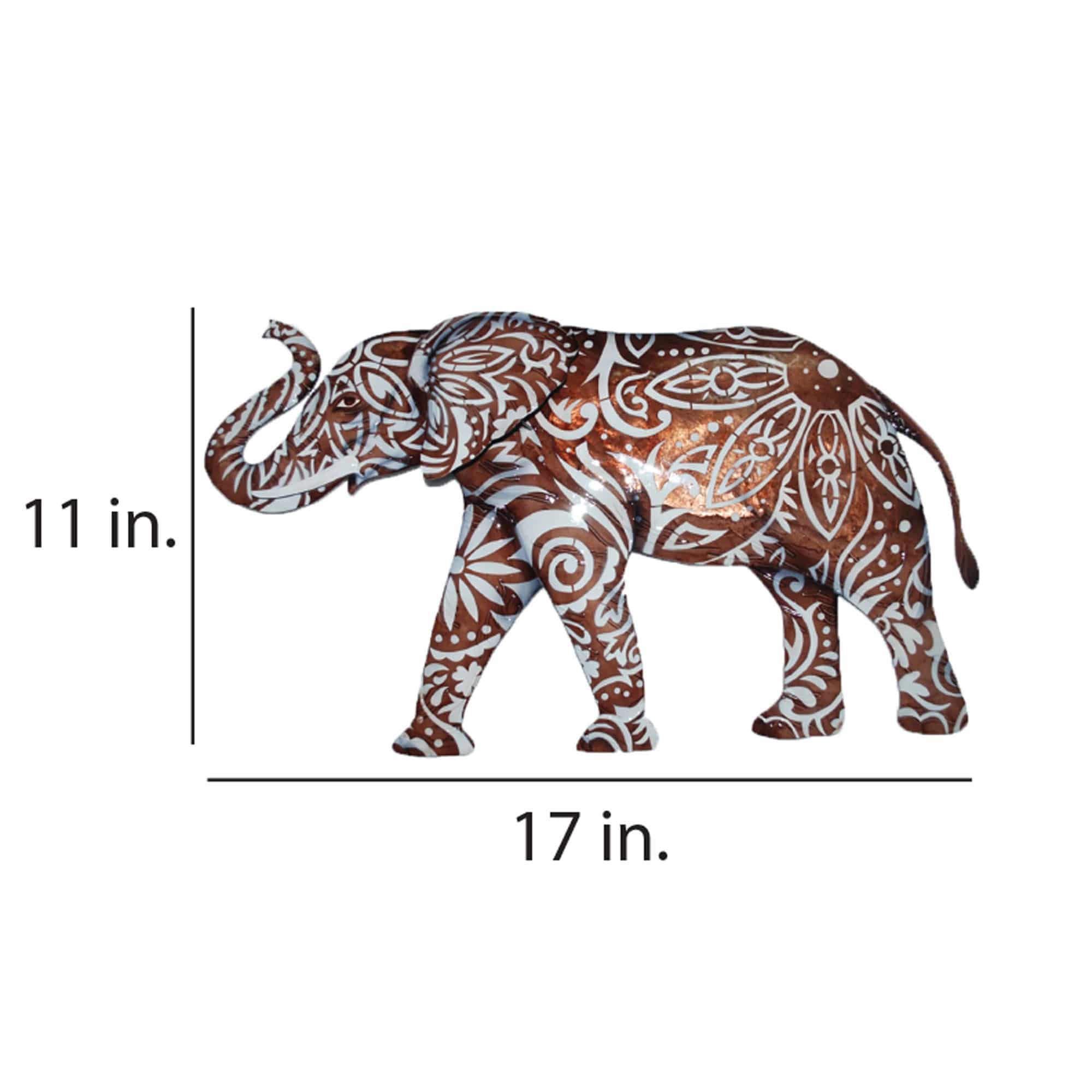
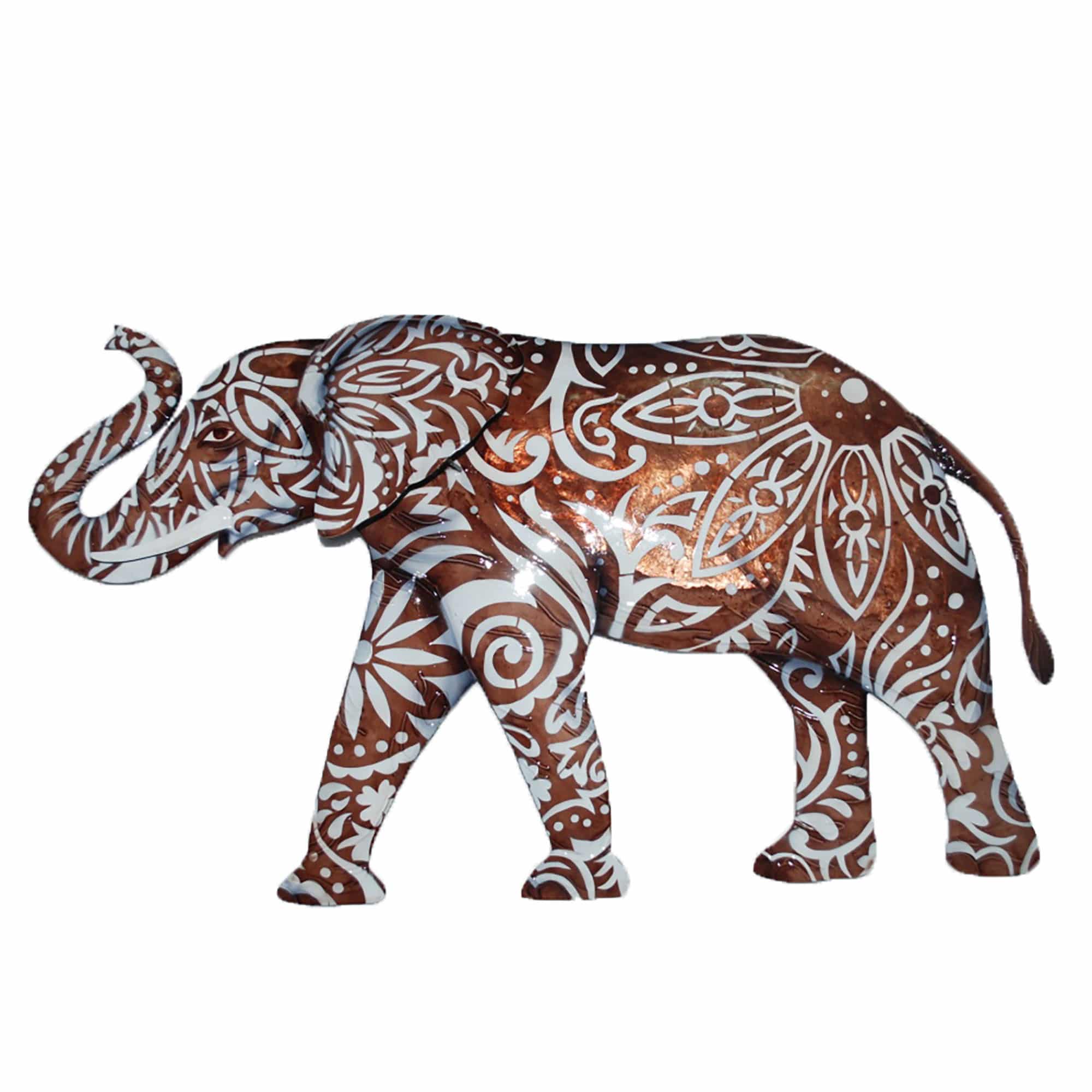 According to feng shui, an elephant with its trunk raised will shower good luck to those around it. It is a symbol for intelligence, curiosity, kindness and strength. The basic shape of this handcrafted metal elephant has its powerful trunk raised due to the importance of the symbolism. Furthermore, the artisan hand-paints the body in a colorful pattern influenced by designs from different Eastern cultures. Placing such a symbol near a door is said to welcome beneficial energy into that space. The basic frame of the is created using tin, which is powder coated with a black finish. The frame is reinforced using tin wire along the inner edge. Capiz is an oyster shell and the primary purpose of the oyster is as a source of food. However, the by-product, the shell, can be used for decoration. Due to it being a natural material, the natural colors of the capiz come through as tans and browns underneath the paint. The shell is then painted the bold colors you see. The entire front facing piece is carefully hand-painted.
According to feng shui, an elephant with its trunk raised will shower good luck to those around it. It is a symbol for intelligence, curiosity, kindness and strength. The basic shape of this handcrafted metal elephant has its powerful trunk raised due to the importance of the symbolism. Furthermore, the artisan hand-paints the body in a colorful pattern influenced by designs from different Eastern cultures. Placing such a symbol near a door is said to welcome beneficial energy into that space. The basic frame of the is created using tin, which is powder coated with a black finish. The frame is reinforced using tin wire along the inner edge. Capiz is an oyster shell and the primary purpose of the oyster is as a source of food. However, the by-product, the shell, can be used for decoration. Due to it being a natural material, the natural colors of the capiz come through as tans and browns underneath the paint. The shell is then painted the bold colors you see. The entire front facing piece is carefully hand-painted. -
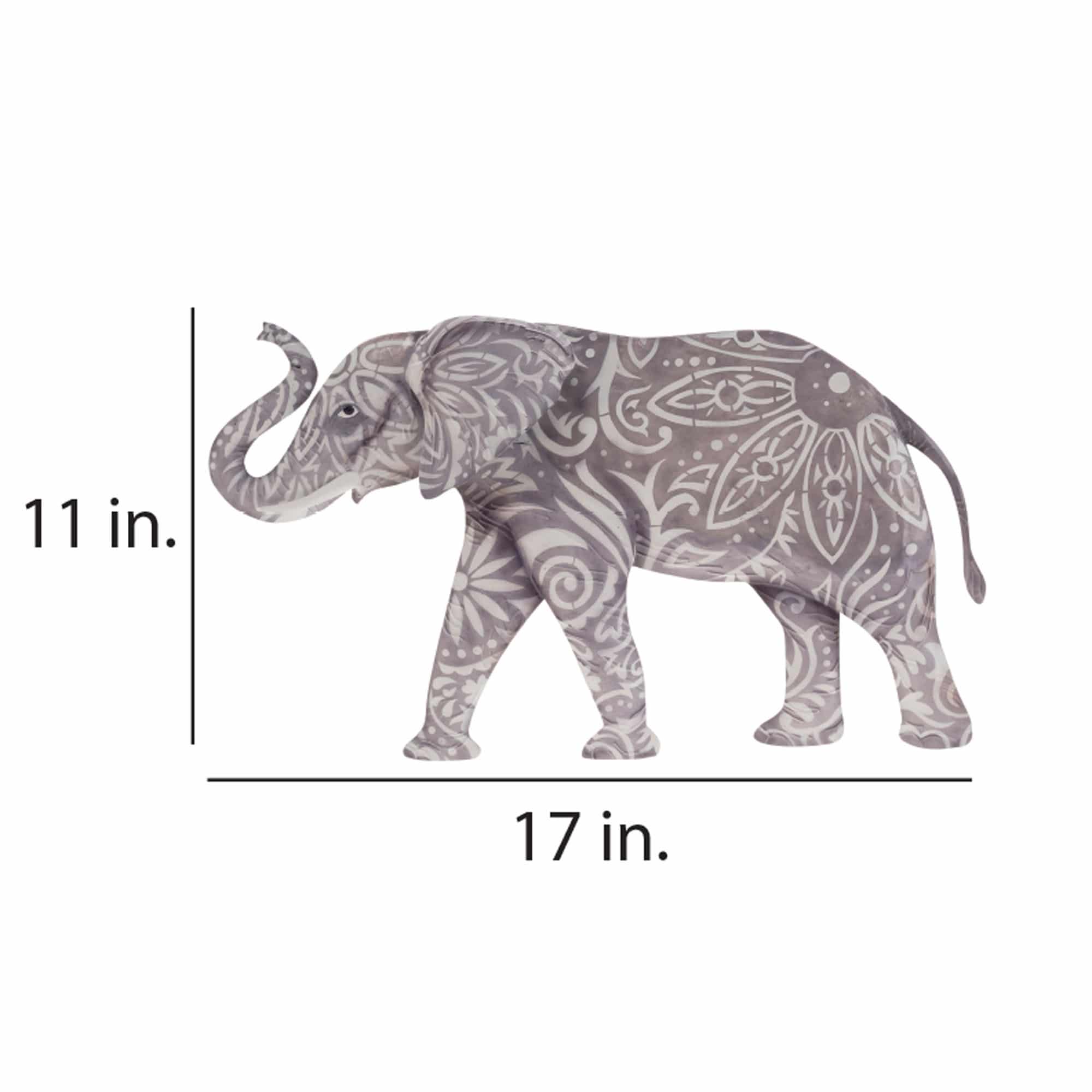
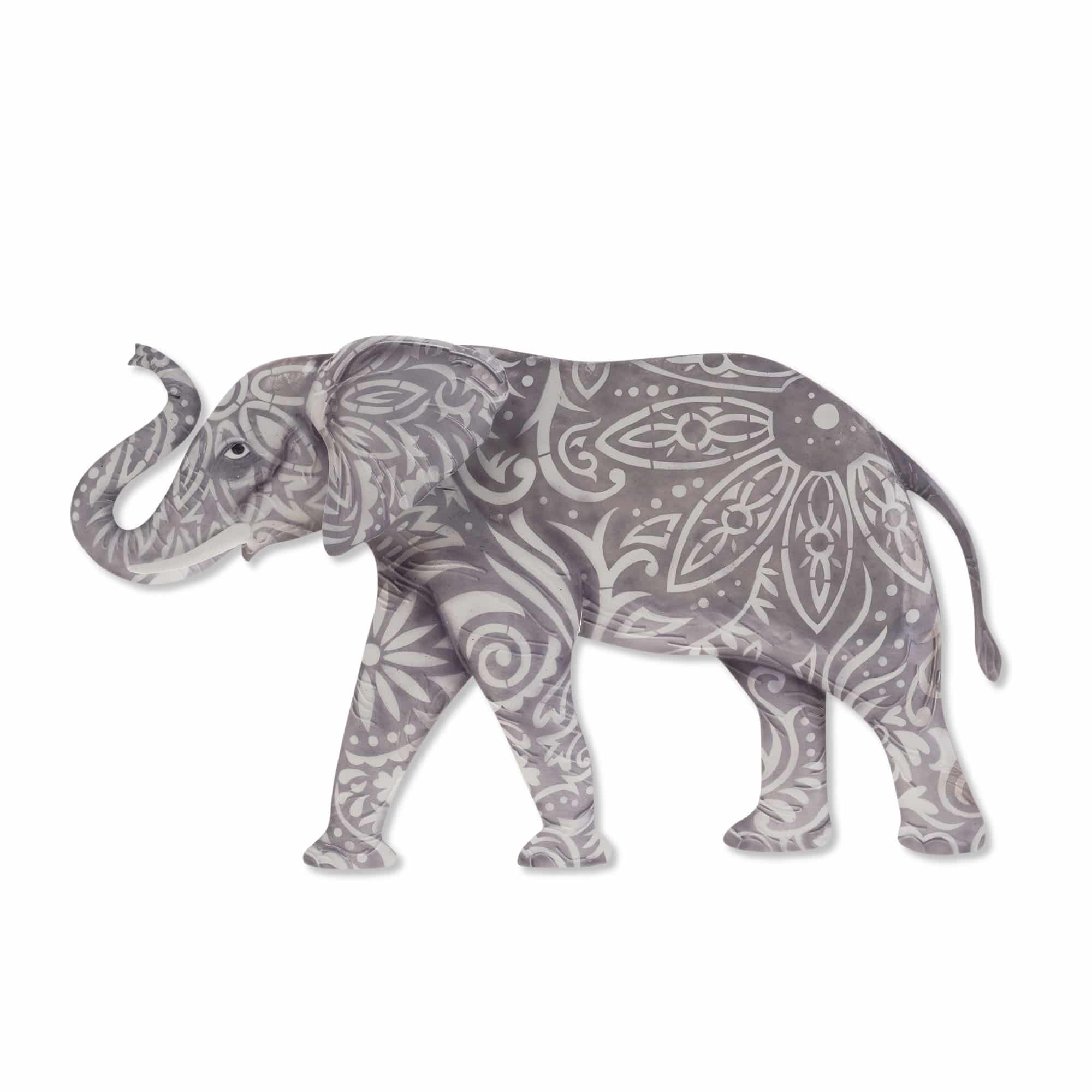 According to feng shui, an elephant with its trunk raised will shower good luck to those around it. It is a symbol for intelligence, curiosity, kindness and strength. The basic shape of this handcrafted metal elephant has its powerful trunk raised due to the importance of the symbolism. Furthermore, the artisan hand-paints the body in a colorful pattern influenced by designs from different Eastern cultures. Placing such a symbol near a door is said to welcome beneficial energy into that space. The basic frame of the is created using tin, which is powder coated with a black finish. The frame is reinforced using tin wire along the inner edge. Capiz is an oyster shell and the primary purpose of the oyster is as a source of food. However, the by-product, the shell, can be used for decoration. Due to it being a natural material, the natural colors of the capiz come through as tans and browns underneath the paint. The shell is then painted the bold colors you see. The entire front facing piece is carefully hand-painted.
According to feng shui, an elephant with its trunk raised will shower good luck to those around it. It is a symbol for intelligence, curiosity, kindness and strength. The basic shape of this handcrafted metal elephant has its powerful trunk raised due to the importance of the symbolism. Furthermore, the artisan hand-paints the body in a colorful pattern influenced by designs from different Eastern cultures. Placing such a symbol near a door is said to welcome beneficial energy into that space. The basic frame of the is created using tin, which is powder coated with a black finish. The frame is reinforced using tin wire along the inner edge. Capiz is an oyster shell and the primary purpose of the oyster is as a source of food. However, the by-product, the shell, can be used for decoration. Due to it being a natural material, the natural colors of the capiz come through as tans and browns underneath the paint. The shell is then painted the bold colors you see. The entire front facing piece is carefully hand-painted. -
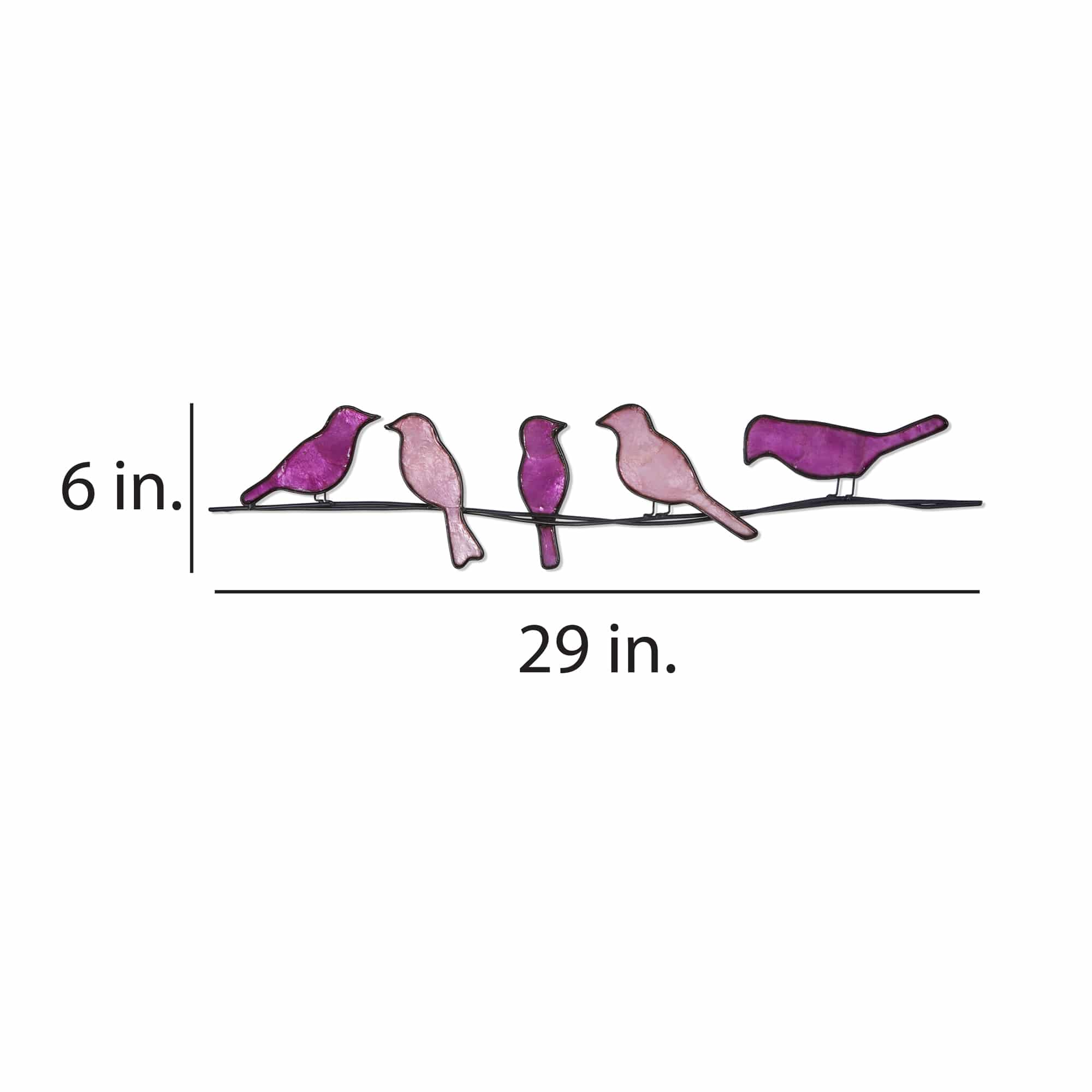
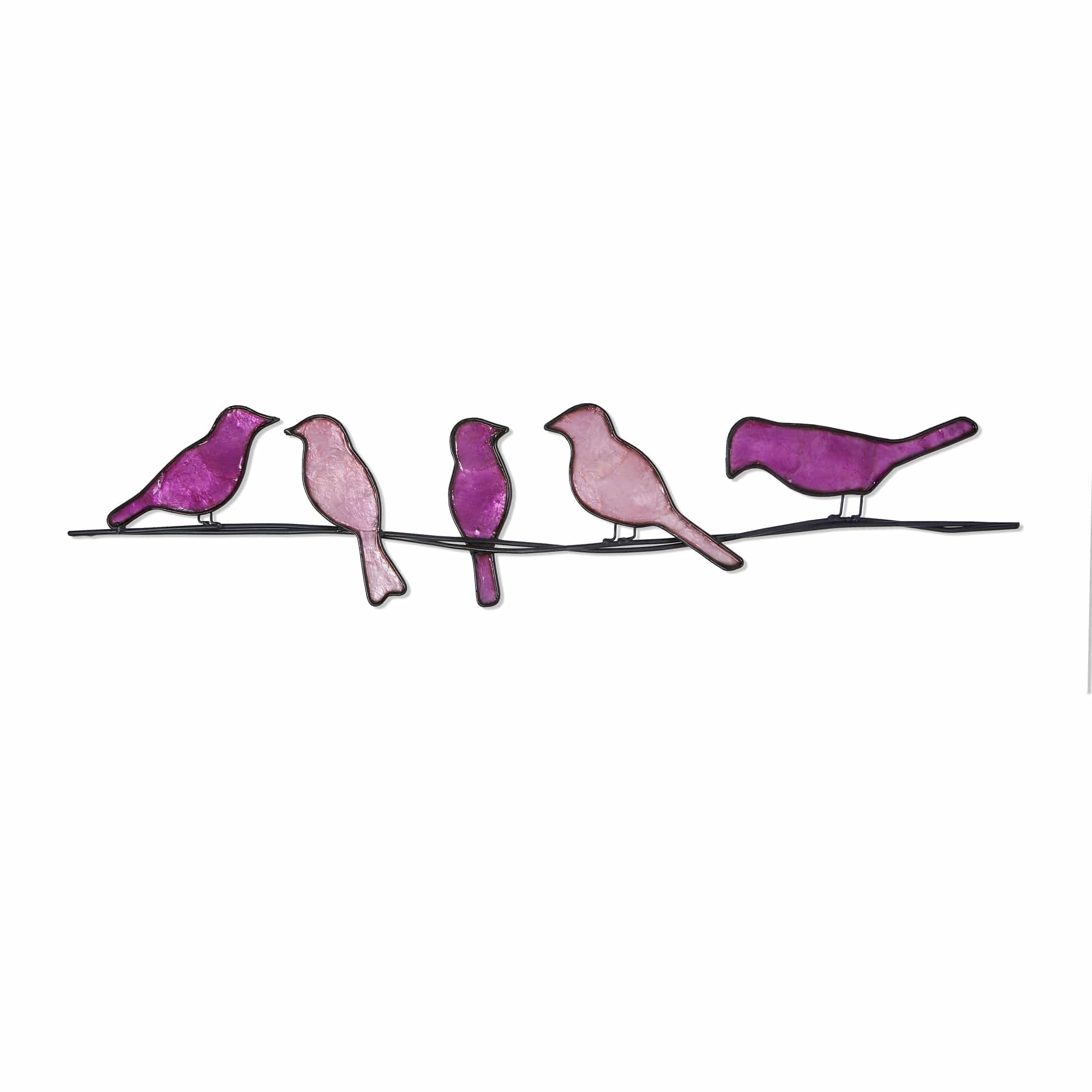 An old parable states that five birds were resting on a wire. Two decided to fly south. How many were birds are left? One's initial answer may be three, however, the answer is still five. The moral of the fable is actions are more important than intention; a kind reminder that a truer picture of one's character is drawn by actions. The artisan captures this parable by lining up five birds socializing on a wire. The basic frame of this piece is created using tin, which is powder coated with a black finish. The frame is reinforced using tin wire along the inner edge. The front of the body is adorned with capiz. Capiz is an oyster shell and the primary purpose of the oyster is as a source of food. However, the by-product, the shell, can be used for decoration. Due to it being a natural material, the natural colors of the capiz may come through as tans and browns underneath the hand-painted surface.
An old parable states that five birds were resting on a wire. Two decided to fly south. How many were birds are left? One's initial answer may be three, however, the answer is still five. The moral of the fable is actions are more important than intention; a kind reminder that a truer picture of one's character is drawn by actions. The artisan captures this parable by lining up five birds socializing on a wire. The basic frame of this piece is created using tin, which is powder coated with a black finish. The frame is reinforced using tin wire along the inner edge. The front of the body is adorned with capiz. Capiz is an oyster shell and the primary purpose of the oyster is as a source of food. However, the by-product, the shell, can be used for decoration. Due to it being a natural material, the natural colors of the capiz may come through as tans and browns underneath the hand-painted surface. -

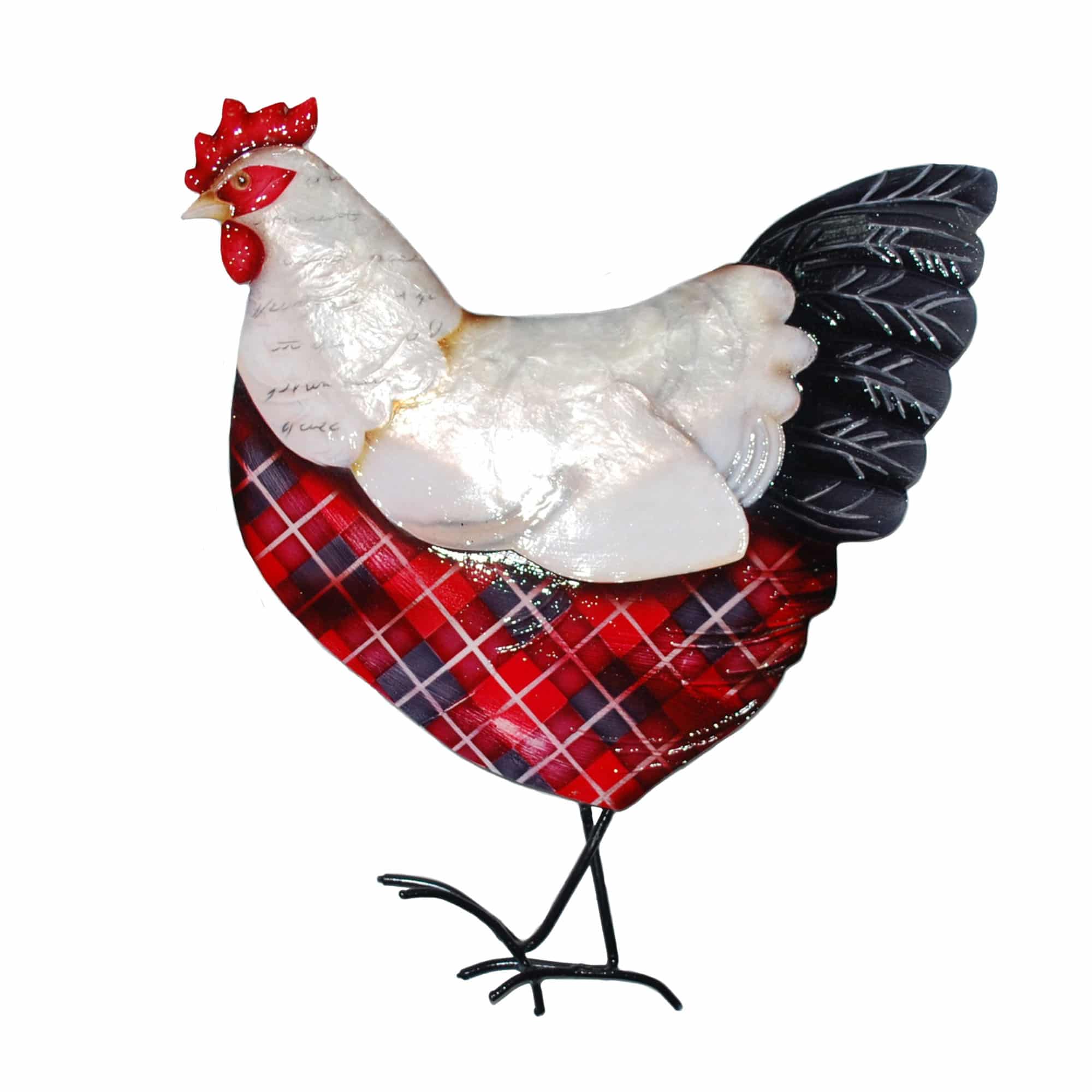 Farm animals are a common theme in the modern farmhouse design with plaid often used as an accent. Featuring modern farmhouse themes, this chicken is both classic and fun in the way the basic colors are portrayed on the familiar design shape. The mother of pearl oyster shell gives the piece an aged patina Modern farmhouse themes also about bringing the old back to new. As an added detail, the neck of the chicken features an excerpt of an old handwritten letter. The basic frame of this piece is created using tin, which is powder coated with a black finish. The frame is reinforced using tin wire along the inner edge. The front of the body is adorned with capiz. Capiz is an oyster shell and the primary purpose of the oyster is as a source of food. However, the by-product, the shell, can be used for decoration. Due to it being a natural material, the natural colors of the capiz may come through as tans and browns underneath the hand-painted surface.
Farm animals are a common theme in the modern farmhouse design with plaid often used as an accent. Featuring modern farmhouse themes, this chicken is both classic and fun in the way the basic colors are portrayed on the familiar design shape. The mother of pearl oyster shell gives the piece an aged patina Modern farmhouse themes also about bringing the old back to new. As an added detail, the neck of the chicken features an excerpt of an old handwritten letter. The basic frame of this piece is created using tin, which is powder coated with a black finish. The frame is reinforced using tin wire along the inner edge. The front of the body is adorned with capiz. Capiz is an oyster shell and the primary purpose of the oyster is as a source of food. However, the by-product, the shell, can be used for decoration. Due to it being a natural material, the natural colors of the capiz may come through as tans and browns underneath the hand-painted surface. -
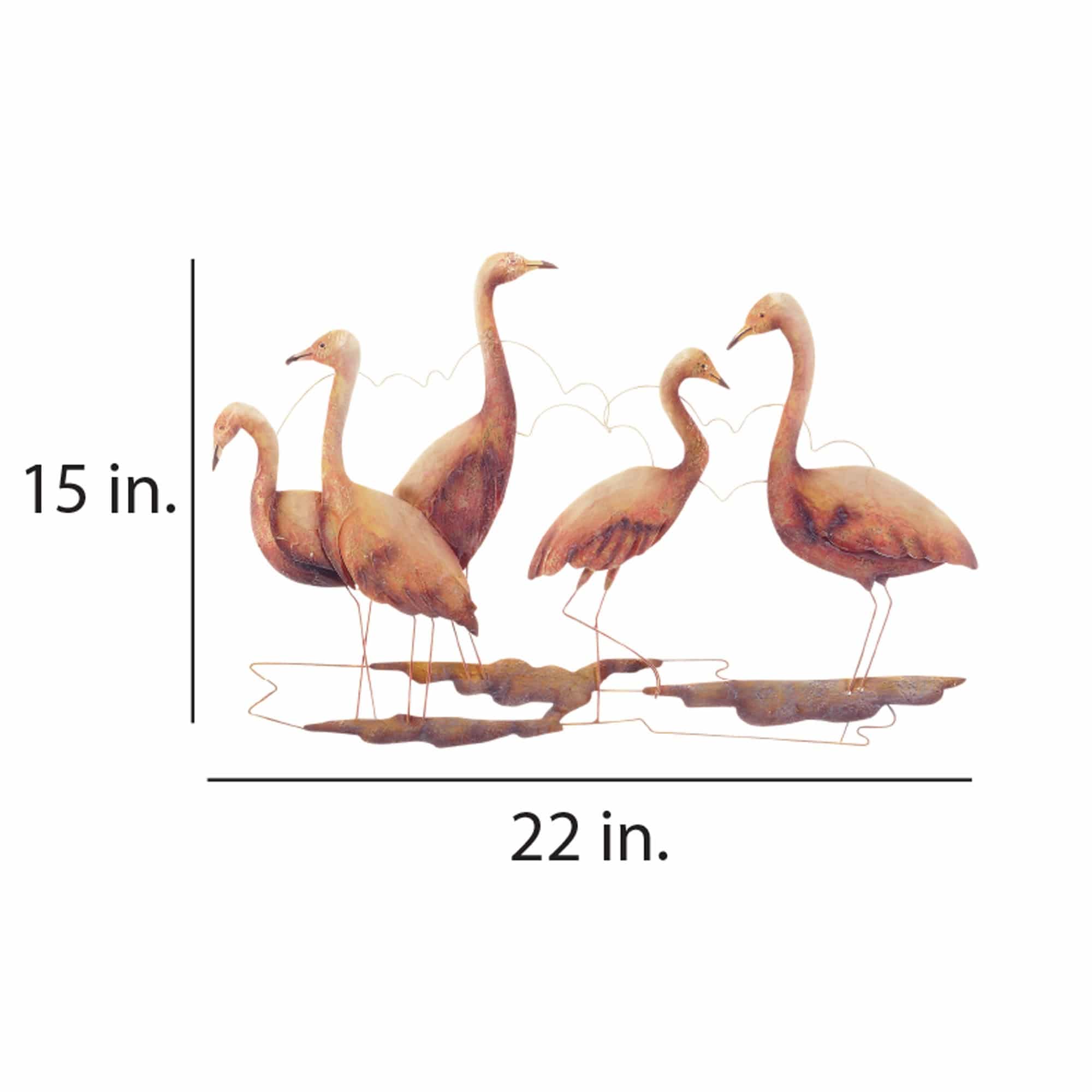
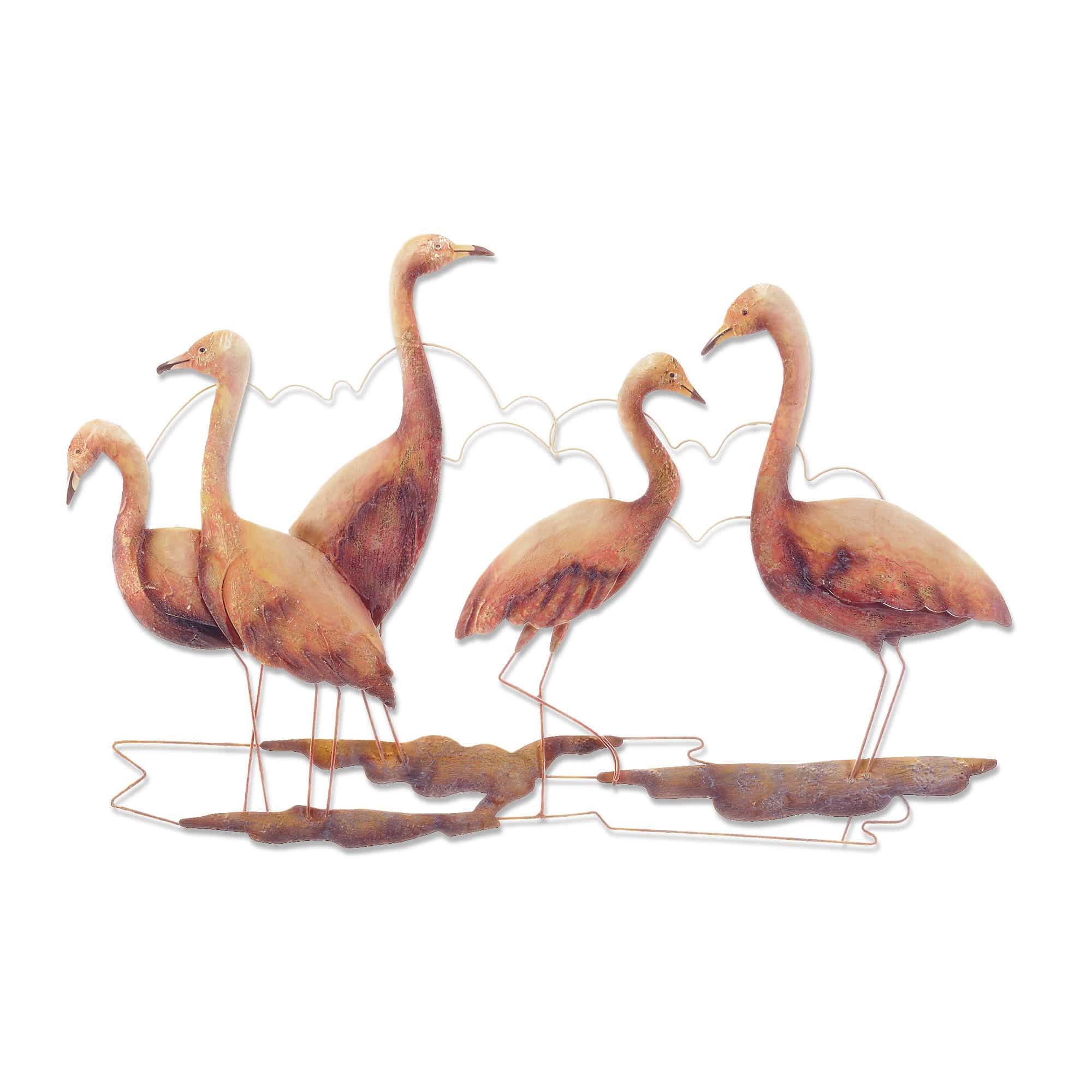 The name 'flamingo' comes from the Portuguese or Spanish 'flamengo,' which means 'flame-colored.' Born gray in hues, flamingos get their flamboyant color from brine shrimp that make up most of their diet. Flamingos are very social animals and the artist depicts this by creating a group of five birds wading through the calm water enjoying a warm day. The artist takes time in pressing the metal creating texture in the wings and body, and also uses metallic paints to highlight the famous colors of one of the most recognizable birds on the planet. The basic frame of this piece is created using tin, which is powder coated with a black finish. The frame is reinforced using tin wire along the inner edge. The front of the body is adorned with capiz. Capiz is an oyster shell and the primary purpose of the oyster is as a source of food. However, the by-product, the shell, can be used for decoration. Due to it being a natural material, the natural colors of the capiz may come through as tans and browns underneath the hand-painted surface.
The name 'flamingo' comes from the Portuguese or Spanish 'flamengo,' which means 'flame-colored.' Born gray in hues, flamingos get their flamboyant color from brine shrimp that make up most of their diet. Flamingos are very social animals and the artist depicts this by creating a group of five birds wading through the calm water enjoying a warm day. The artist takes time in pressing the metal creating texture in the wings and body, and also uses metallic paints to highlight the famous colors of one of the most recognizable birds on the planet. The basic frame of this piece is created using tin, which is powder coated with a black finish. The frame is reinforced using tin wire along the inner edge. The front of the body is adorned with capiz. Capiz is an oyster shell and the primary purpose of the oyster is as a source of food. However, the by-product, the shell, can be used for decoration. Due to it being a natural material, the natural colors of the capiz may come through as tans and browns underneath the hand-painted surface. -
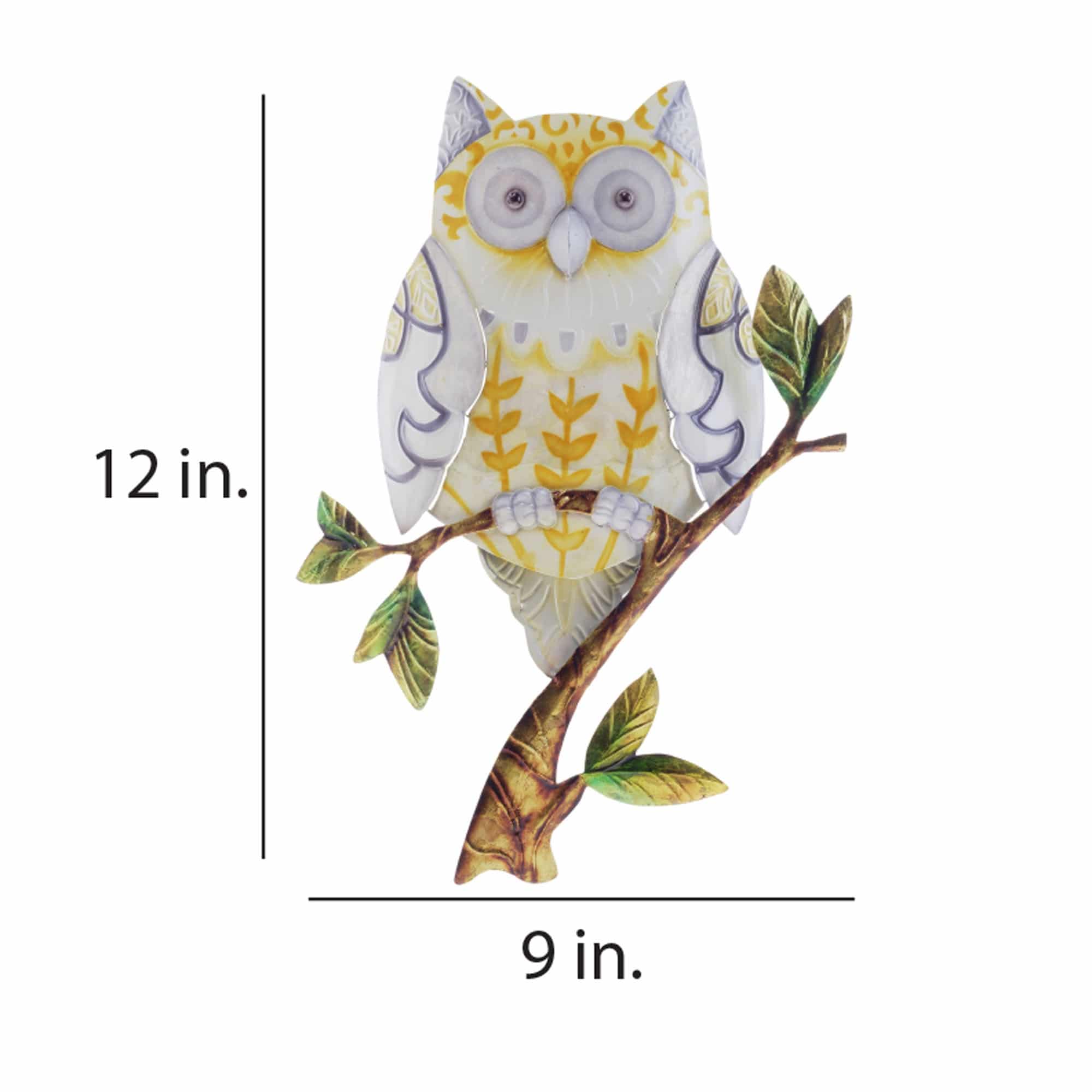
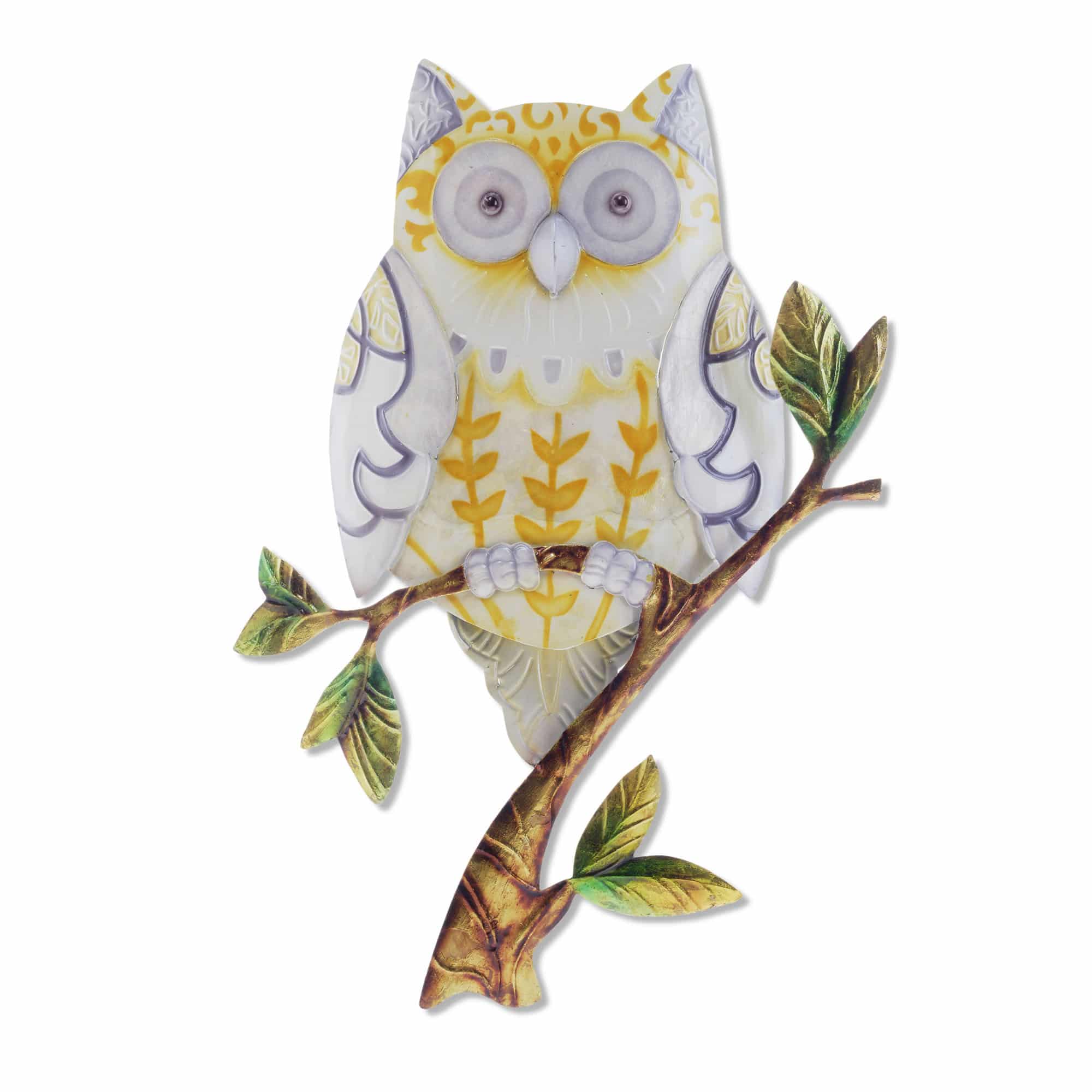 The owl was a bird of prophecy and wisdom in many ancient cultures. Its wide eyes seem to miss nothing and when an owl moves it seems calculated. Even though the colors and designs on the owl are human interpretations, the perched look is defiantly natural. The artist uses capiz shell on the wings to highlight the reflective nature of some of the owl's feathers. The basic frame of the owl is created using tin, which is powder coated with a black finish. The frame is reinforced using tin wire along the inner edge. Capiz is an oyster shell and the primary purpose of the oyster is as a source of food. However, the by-product, the shell, can be used for decoration.
The owl was a bird of prophecy and wisdom in many ancient cultures. Its wide eyes seem to miss nothing and when an owl moves it seems calculated. Even though the colors and designs on the owl are human interpretations, the perched look is defiantly natural. The artist uses capiz shell on the wings to highlight the reflective nature of some of the owl's feathers. The basic frame of the owl is created using tin, which is powder coated with a black finish. The frame is reinforced using tin wire along the inner edge. Capiz is an oyster shell and the primary purpose of the oyster is as a source of food. However, the by-product, the shell, can be used for decoration. -
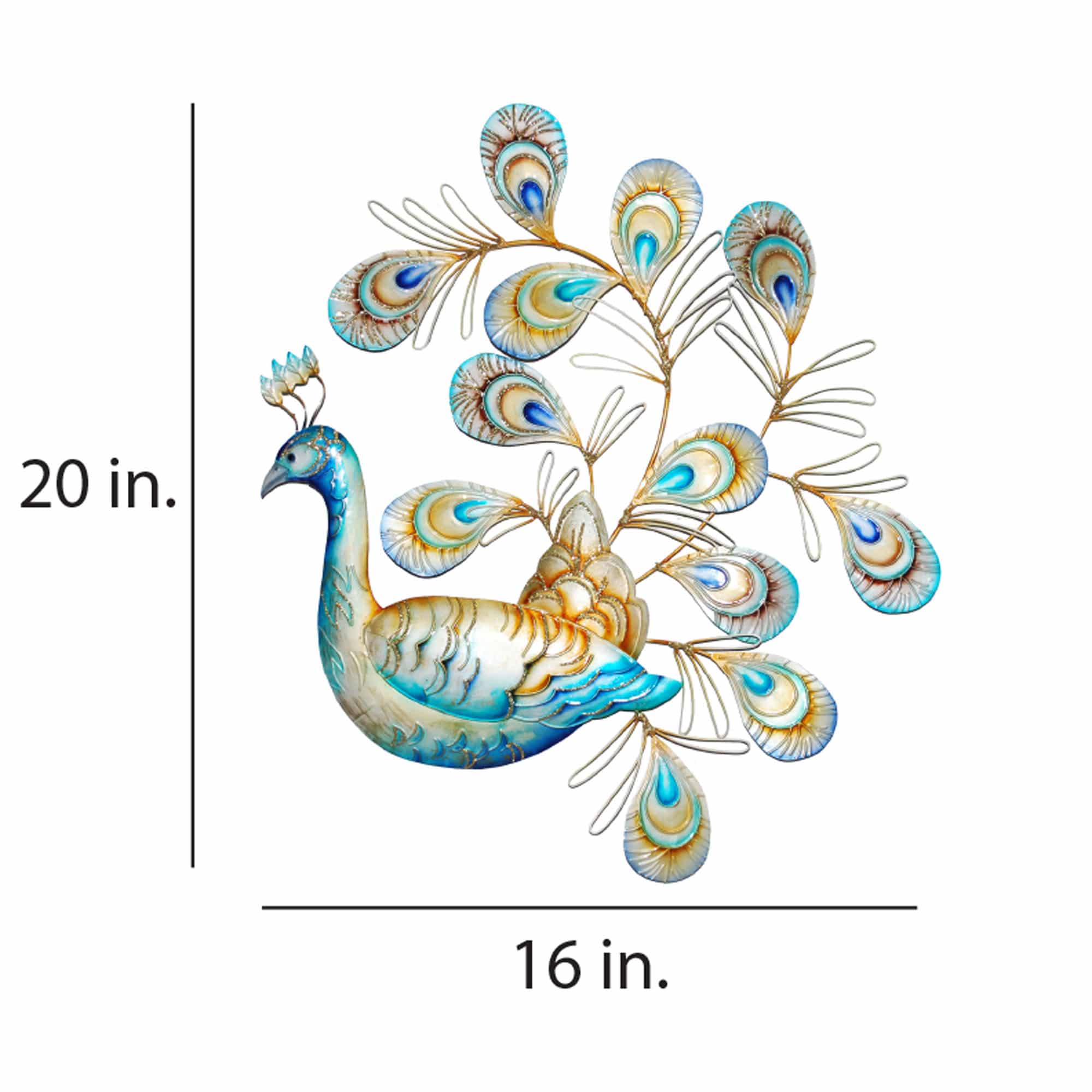
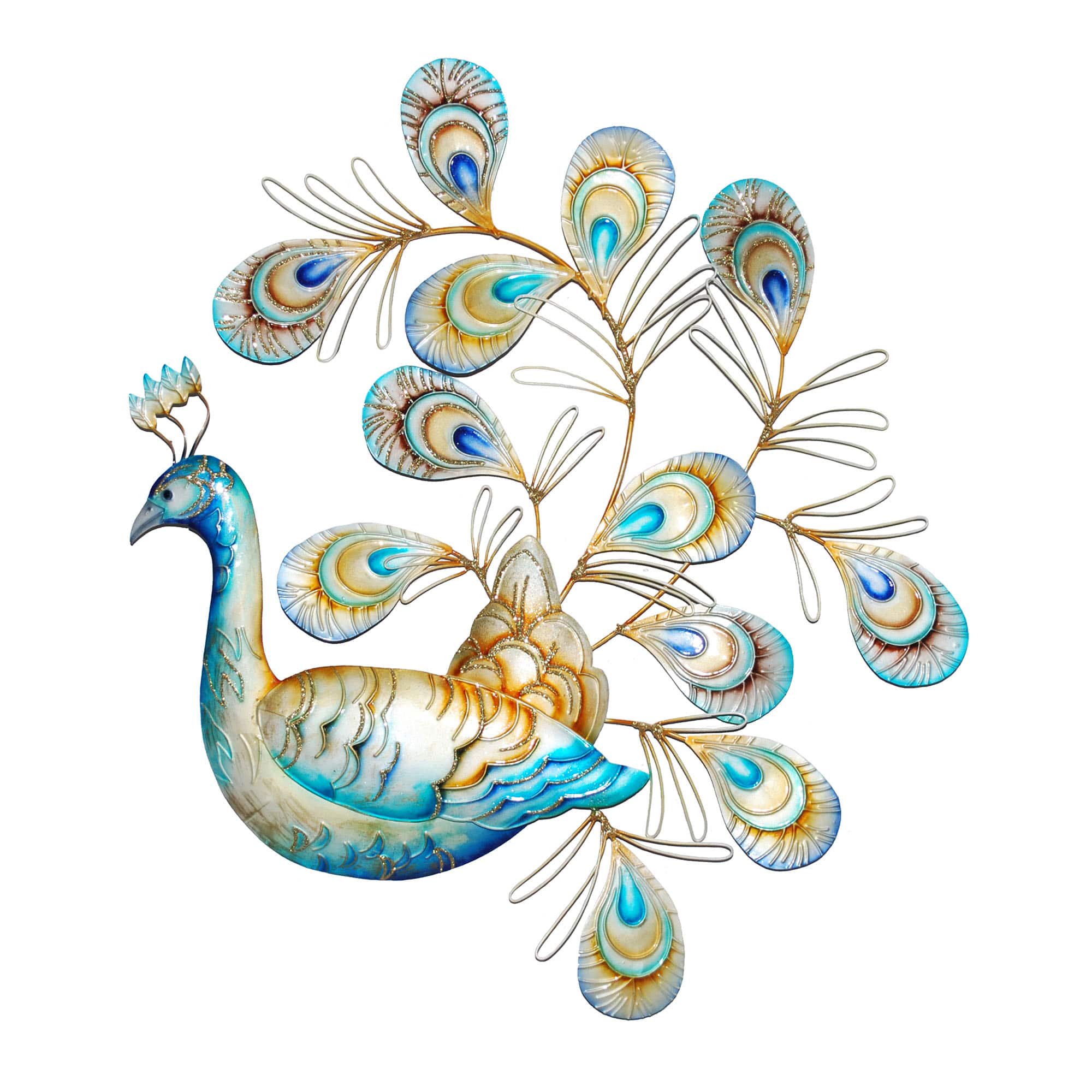 Tailfeathers raised, this Indian peacock is strutting his stuff. On display is its iridescent blue and green, metallic-colored, plumage. Throughout its tailfeathers, the artists drew in the peacock's distinctive eyespots, with the eye itself in different colors. The chest of the bird is crafted from capiz shell, carefully painted in the blues and greens this bird is known for. It fits perfectly within any decor style and will add the finishing touch to its surroundings. The basic frame of this piece is created using tin, which is powder coated with a black finish. The frame is reinforced using tin wire along the inner edge. The front of the body is adorned with capiz. Capiz is an oyster shell and the primary purpose of the oyster is as a source of food. However, the by-product, the shell, can be used for decoration. Due to it being a natural material, the natural colors of the capiz may come through as tans and browns underneath the hand-painted surface.
Tailfeathers raised, this Indian peacock is strutting his stuff. On display is its iridescent blue and green, metallic-colored, plumage. Throughout its tailfeathers, the artists drew in the peacock's distinctive eyespots, with the eye itself in different colors. The chest of the bird is crafted from capiz shell, carefully painted in the blues and greens this bird is known for. It fits perfectly within any decor style and will add the finishing touch to its surroundings. The basic frame of this piece is created using tin, which is powder coated with a black finish. The frame is reinforced using tin wire along the inner edge. The front of the body is adorned with capiz. Capiz is an oyster shell and the primary purpose of the oyster is as a source of food. However, the by-product, the shell, can be used for decoration. Due to it being a natural material, the natural colors of the capiz may come through as tans and browns underneath the hand-painted surface. -
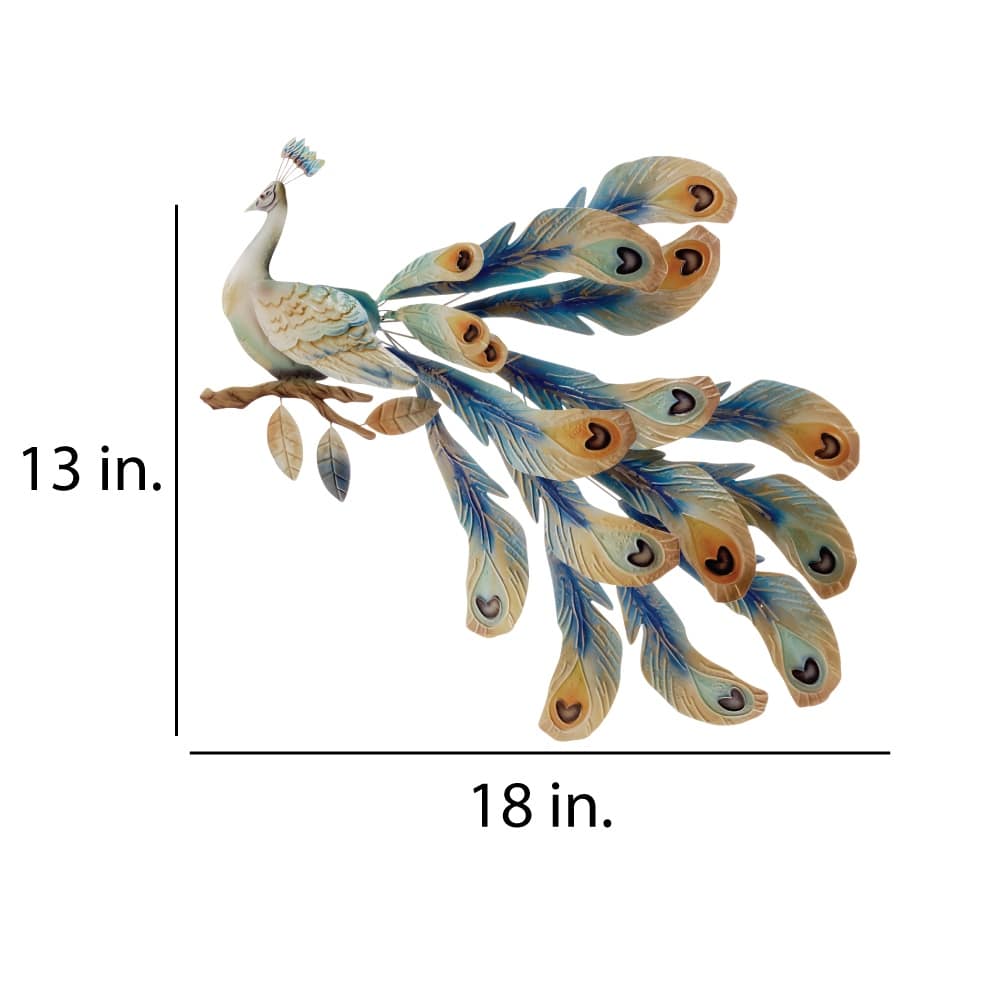
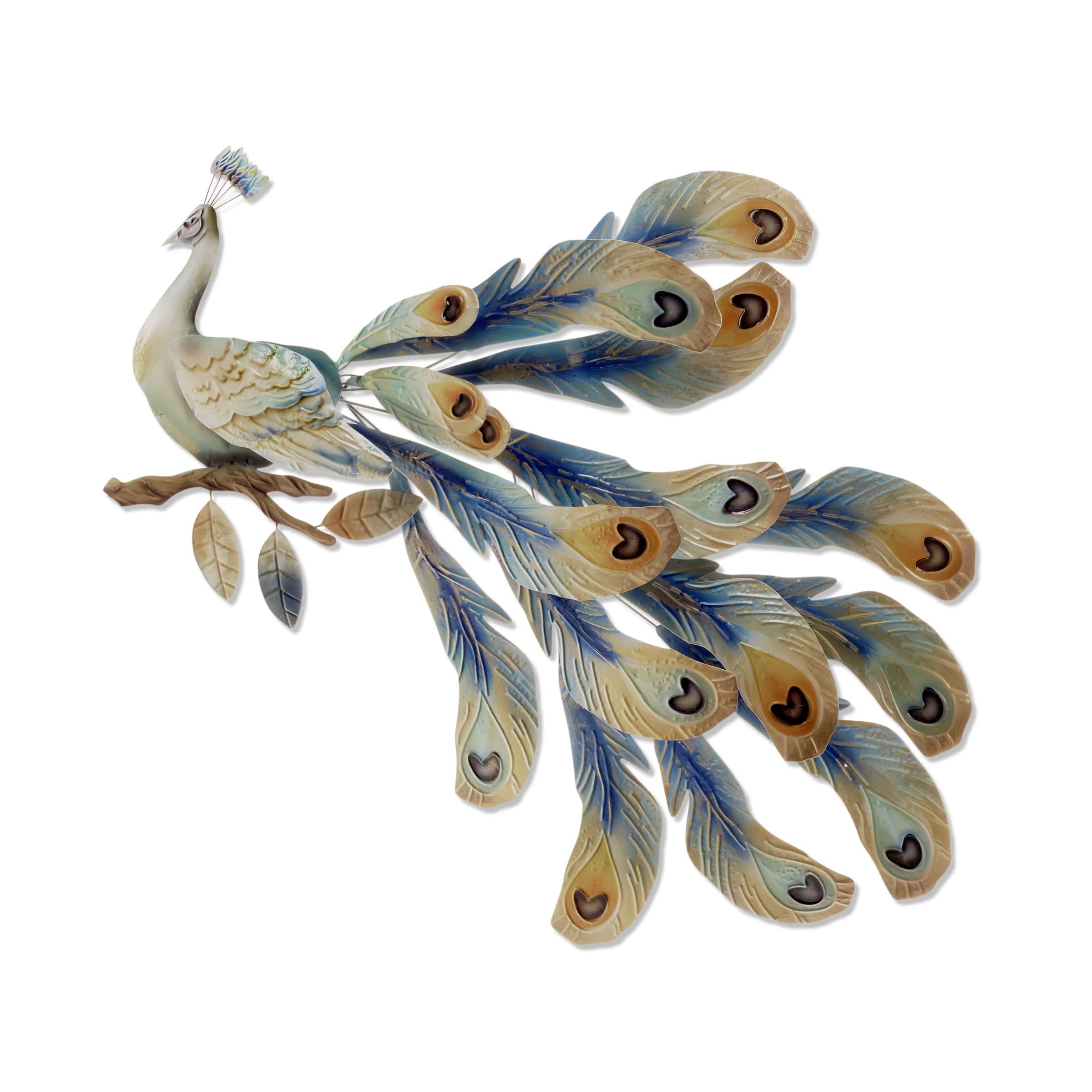 This elegant peacock is relaxed and calm, pluming through its feathers. Throughout its tail-feathers, the artists drew in the peacock's distinctive eyespots, with the eye itself in different colors. The chest of the bird is crafted from capiz shell, carefully painted in the blues and greens this bird is known for. It will fit perfectly within any decor style and add the finishing touch to its surroundings. The basic frame of the cat is created using tin, which is powder coated with a black finish. The frame is reinforced using tin wire along the inner edge. Capiz is an oyster shell and the primary purpose of the oyster is as a source of food. However, the by-product, the shell, can be used for decoration. Due to it being a natural material, the natural colors of the capiz come through as tans and browns underneath the paint. The shell is then painted the bold colors you see. The entire front facing piece is carefully hand-painted.
This elegant peacock is relaxed and calm, pluming through its feathers. Throughout its tail-feathers, the artists drew in the peacock's distinctive eyespots, with the eye itself in different colors. The chest of the bird is crafted from capiz shell, carefully painted in the blues and greens this bird is known for. It will fit perfectly within any decor style and add the finishing touch to its surroundings. The basic frame of the cat is created using tin, which is powder coated with a black finish. The frame is reinforced using tin wire along the inner edge. Capiz is an oyster shell and the primary purpose of the oyster is as a source of food. However, the by-product, the shell, can be used for decoration. Due to it being a natural material, the natural colors of the capiz come through as tans and browns underneath the paint. The shell is then painted the bold colors you see. The entire front facing piece is carefully hand-painted. -

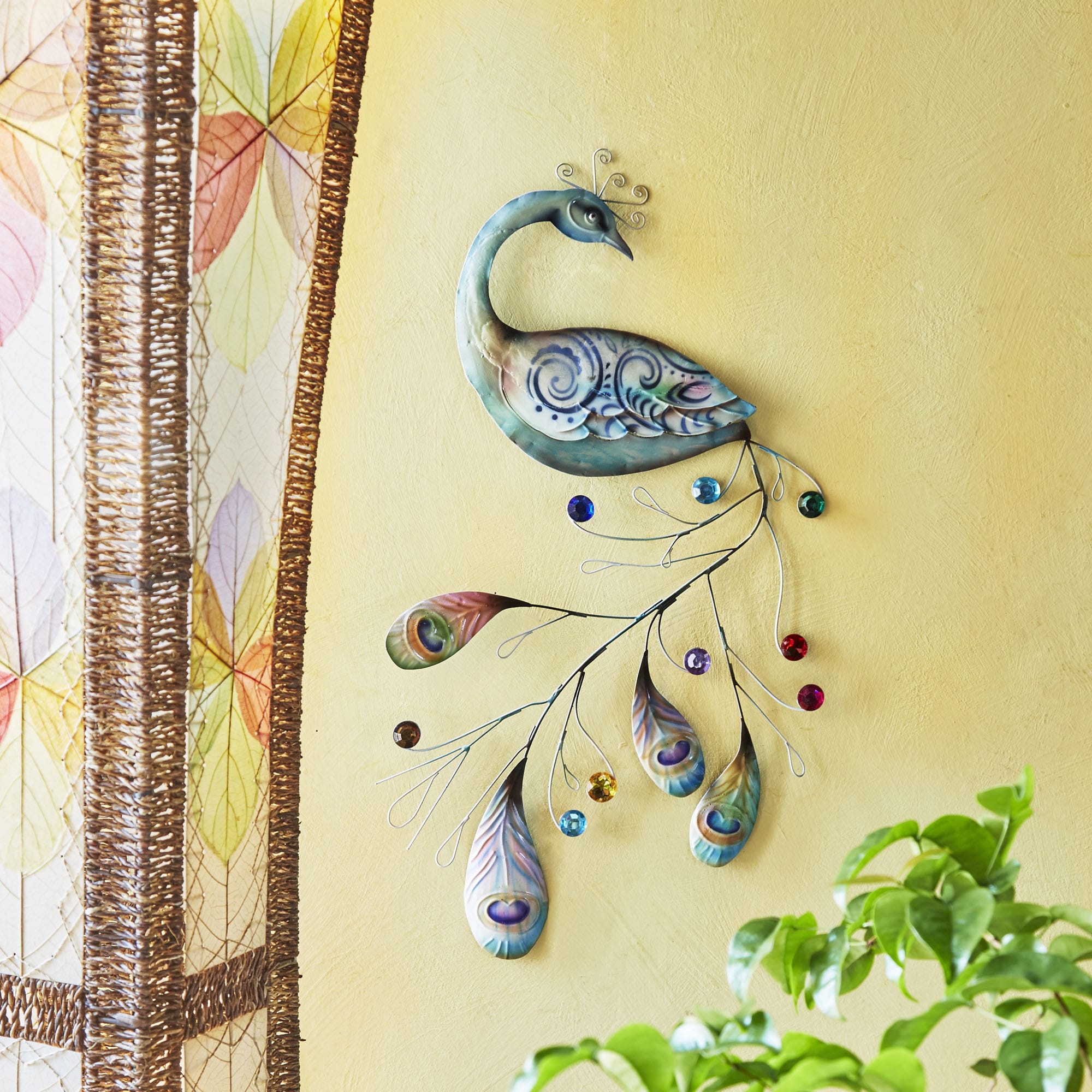
This elegant peacock is relaxed and calm, pluming through its feathers. The gentle hues of its body are enhanced with a pop of color in the jeweled stones in the peacock's tail. The jewels aren't the only representation of the iridescent colors of peacocks. The artist doesn't hesitate to hand-paint the distinctive eyespots, with the eye itself in different colors. This piece comes together and brings a of soothing peace to any space.
The basic frame of the is created using tin, which is powder coated with a black finish. The frame is reinforced using tin wire along the inner edge. Capiz is an oyster shell and the primary purpose of the oyster is as a source of food. However, the by-product, the shell, can be used for decoration. Due to it being a natural material, the natural colors of the capiz come through as tans and browns underneath the paint. The shell is then painted the bold colors you see. The entire front facing piece is carefully hand-painted.
-

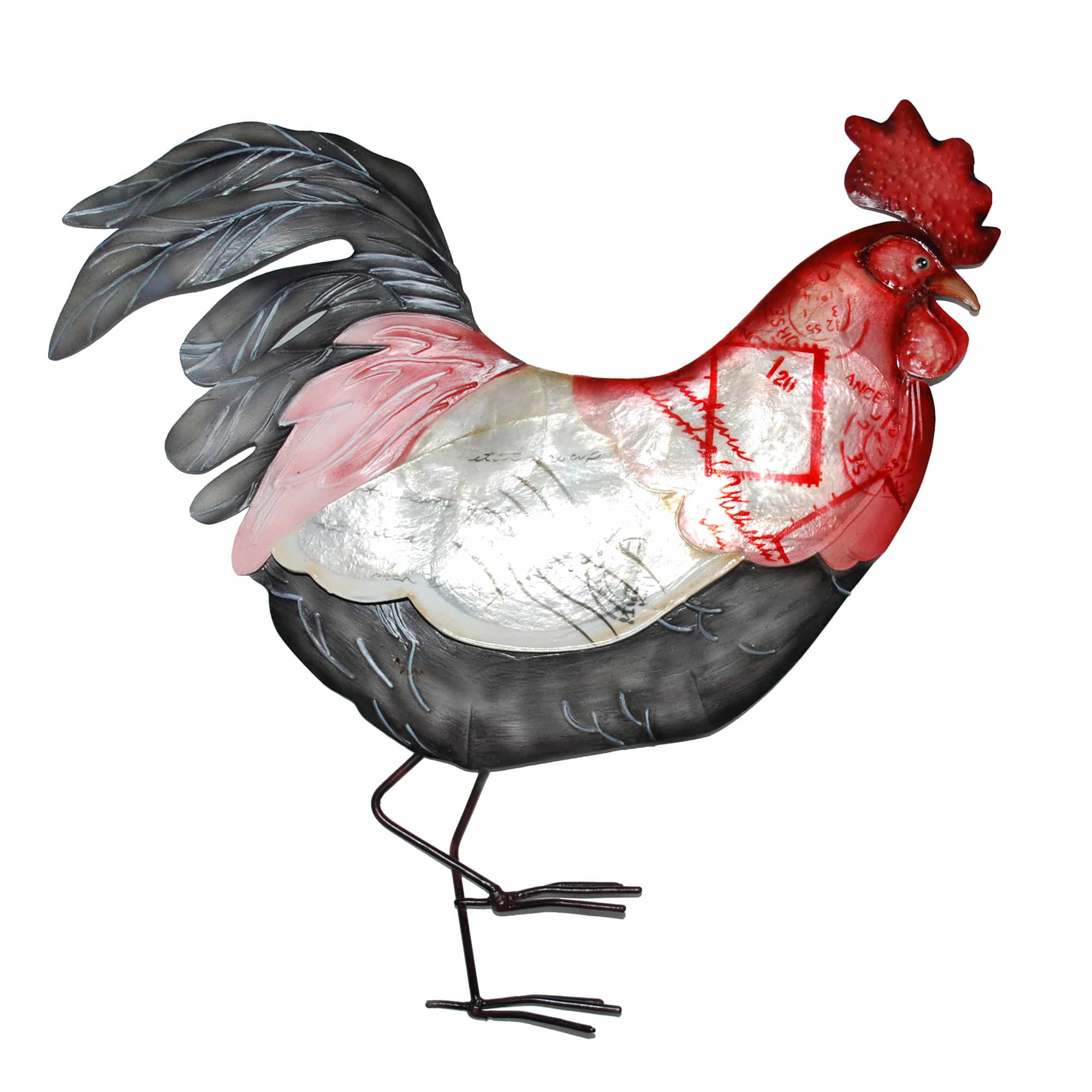 This vintage designed rooster is influenced by the designs of the early 20th century. The artist took great care in making sure the rooster's comb and wattle appear authentic by pressing texture into the metal frame. Furthermore, the artist made sure to use realistic colors and shading. Even the body and the tail feathers were pressed and cut to mimic the body of a real rooster. However, the center of the rooster deviates from the realism and merges into the nostalgic with what appears to be an envelope of an old handwritten letter. The capiz oyster shell gives an aged patina making the rooster and the letter feel like it has been around for a very long time. The letter is an artistic way of tying in a piece of the old into the new. The basic frame of this piece is created using tin, which is powder coated with a black finish. The frame is reinforced using tin wire along the inner edge. The front of the body is adorned with capiz. Capiz is an oyster shell and the primary purpose of the oyster is as a source of food. However, the by-product, the shell, can be used for decoration. Due to it being a natural material, the natural colors of the capiz may come through as tans and browns underneath the hand-painted surface.
This vintage designed rooster is influenced by the designs of the early 20th century. The artist took great care in making sure the rooster's comb and wattle appear authentic by pressing texture into the metal frame. Furthermore, the artist made sure to use realistic colors and shading. Even the body and the tail feathers were pressed and cut to mimic the body of a real rooster. However, the center of the rooster deviates from the realism and merges into the nostalgic with what appears to be an envelope of an old handwritten letter. The capiz oyster shell gives an aged patina making the rooster and the letter feel like it has been around for a very long time. The letter is an artistic way of tying in a piece of the old into the new. The basic frame of this piece is created using tin, which is powder coated with a black finish. The frame is reinforced using tin wire along the inner edge. The front of the body is adorned with capiz. Capiz is an oyster shell and the primary purpose of the oyster is as a source of food. However, the by-product, the shell, can be used for decoration. Due to it being a natural material, the natural colors of the capiz may come through as tans and browns underneath the hand-painted surface. -

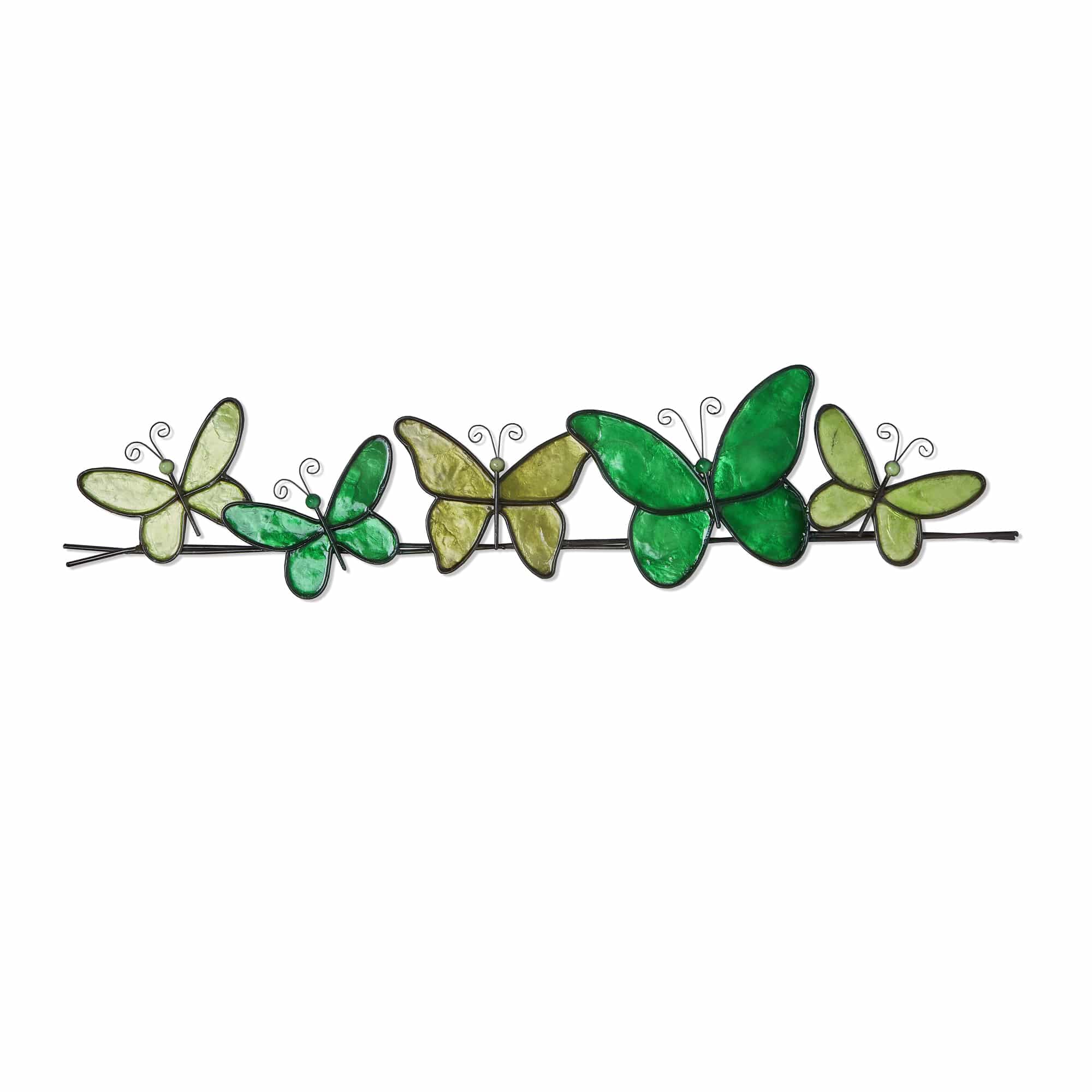 Five, fluttering butterflies are ready to complete their journey after taking a break from a long migration. The slender, metal body of each butterfly connects to colorful capiz-shell wings which catches light and adds shine. Each wing is framed using sturdy wrought iron and reinforced with a metal backing. The basic frame of the butterfly is created using tin, which is powder-coated with a black finish and makes this piece safe to use outdoors. The edges of the frame are reinforced using thicker tin wire. The front of this piece is adorned in areas with capiz shell, an oyster native to the Philippines, before being hand-painted and sealed with a water-based sealant. The primary purpose of this oyster to provide a source of food, however, the shell is a sustainable by-product that can be used for decoration. The capiz shell subtly replicates the reflective qualities of butterflies in nature. The entire piece is lightweight and has an eyelet in the back allowing it to be hung using a finishing nail, command strip, or a push pin. Due to it being a natural material, the organic colors of capiz come through as tans and browns underneath the paint.
Five, fluttering butterflies are ready to complete their journey after taking a break from a long migration. The slender, metal body of each butterfly connects to colorful capiz-shell wings which catches light and adds shine. Each wing is framed using sturdy wrought iron and reinforced with a metal backing. The basic frame of the butterfly is created using tin, which is powder-coated with a black finish and makes this piece safe to use outdoors. The edges of the frame are reinforced using thicker tin wire. The front of this piece is adorned in areas with capiz shell, an oyster native to the Philippines, before being hand-painted and sealed with a water-based sealant. The primary purpose of this oyster to provide a source of food, however, the shell is a sustainable by-product that can be used for decoration. The capiz shell subtly replicates the reflective qualities of butterflies in nature. The entire piece is lightweight and has an eyelet in the back allowing it to be hung using a finishing nail, command strip, or a push pin. Due to it being a natural material, the organic colors of capiz come through as tans and browns underneath the paint. -
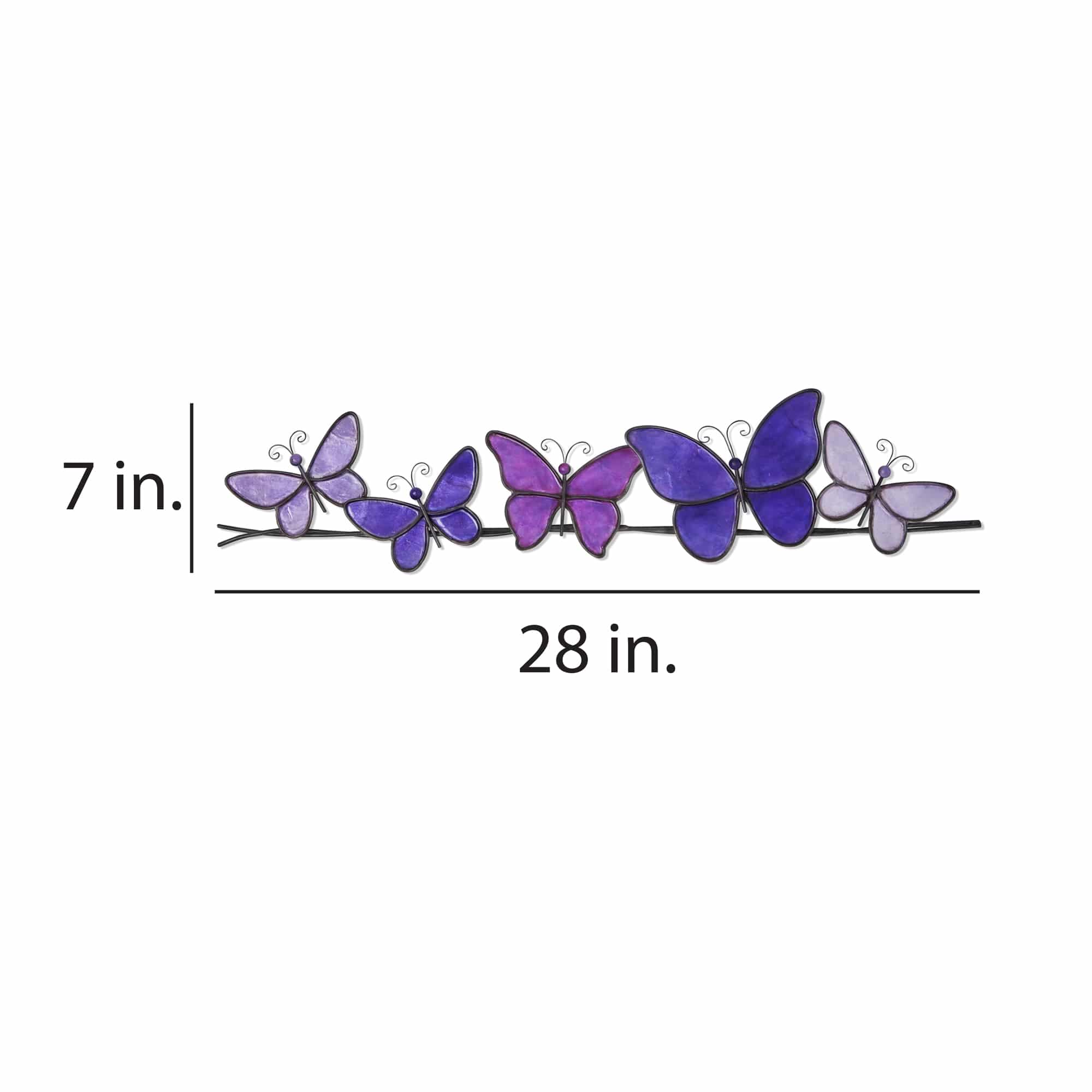
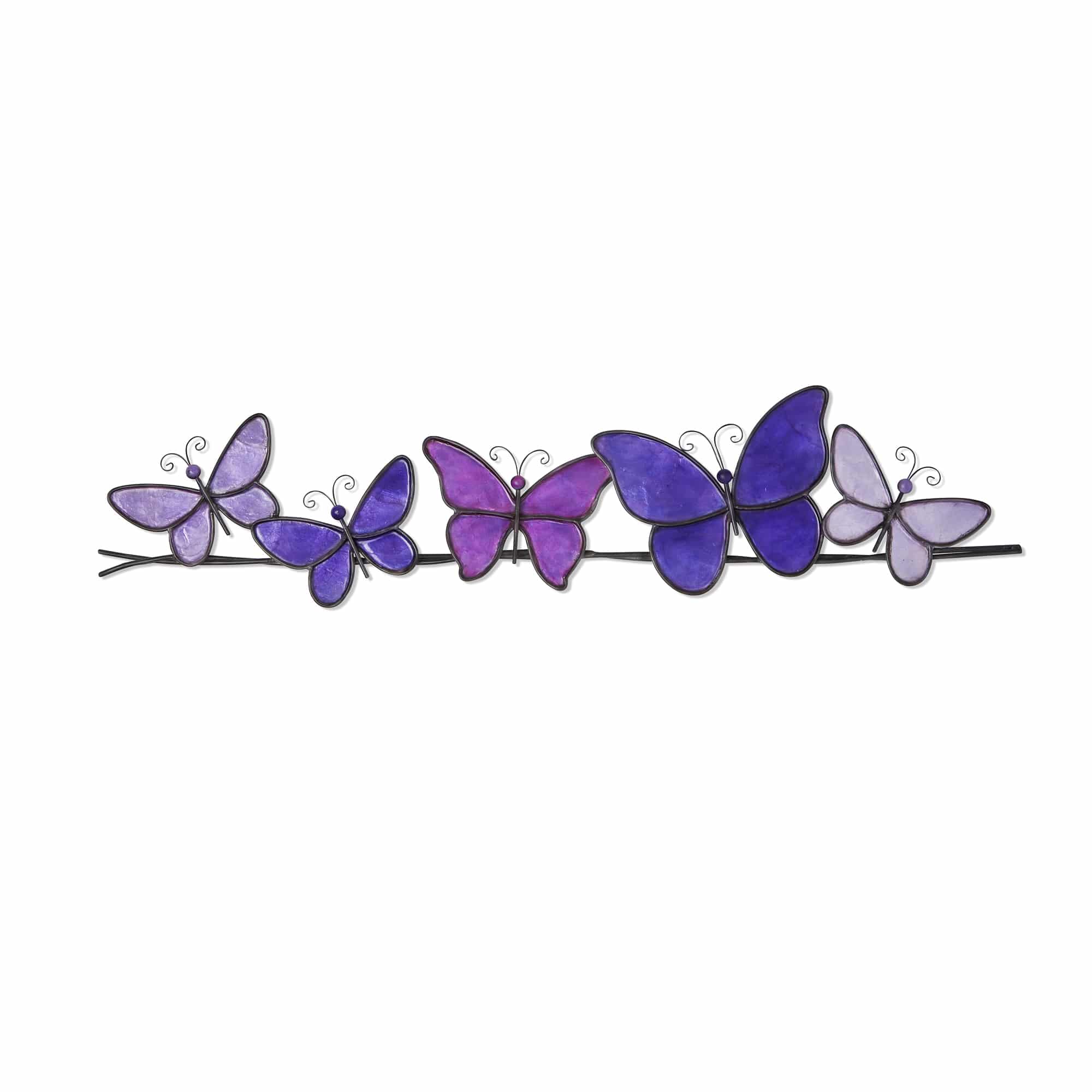
Five, fluttering butterflies are ready to complete their journey after taking a break from a long migration. The slender, metal body of each butterfly connects to colorful capiz-shell wings which catches light and adds shine. Each wing is framed using sturdy wrought iron and reinforced with a metal backing.
The basic frame of the butterfly is created using tin, which is powder-coated with a black finish and makes this piece safe to use outdoors. The edges of the frame are reinforced using thicker tin wire. The front of this piece is adorned in areas with capiz shell, an oyster native to the Philippines, before being hand-painted and sealed with a water-based sealant. The primary purpose of this oyster to provide a source of food, however, the shell is a sustainable by-product that can be used for decoration. The capiz shell subtly replicates the reflective qualities of butterflies in nature. The entire piece is lightweight and has an eyelet in the back allowing it to be hung using a finishing nail, command strip, or a push pin. Due to it being a natural material, the organic colors of capiz come through as tans and browns underneath the paint.
-
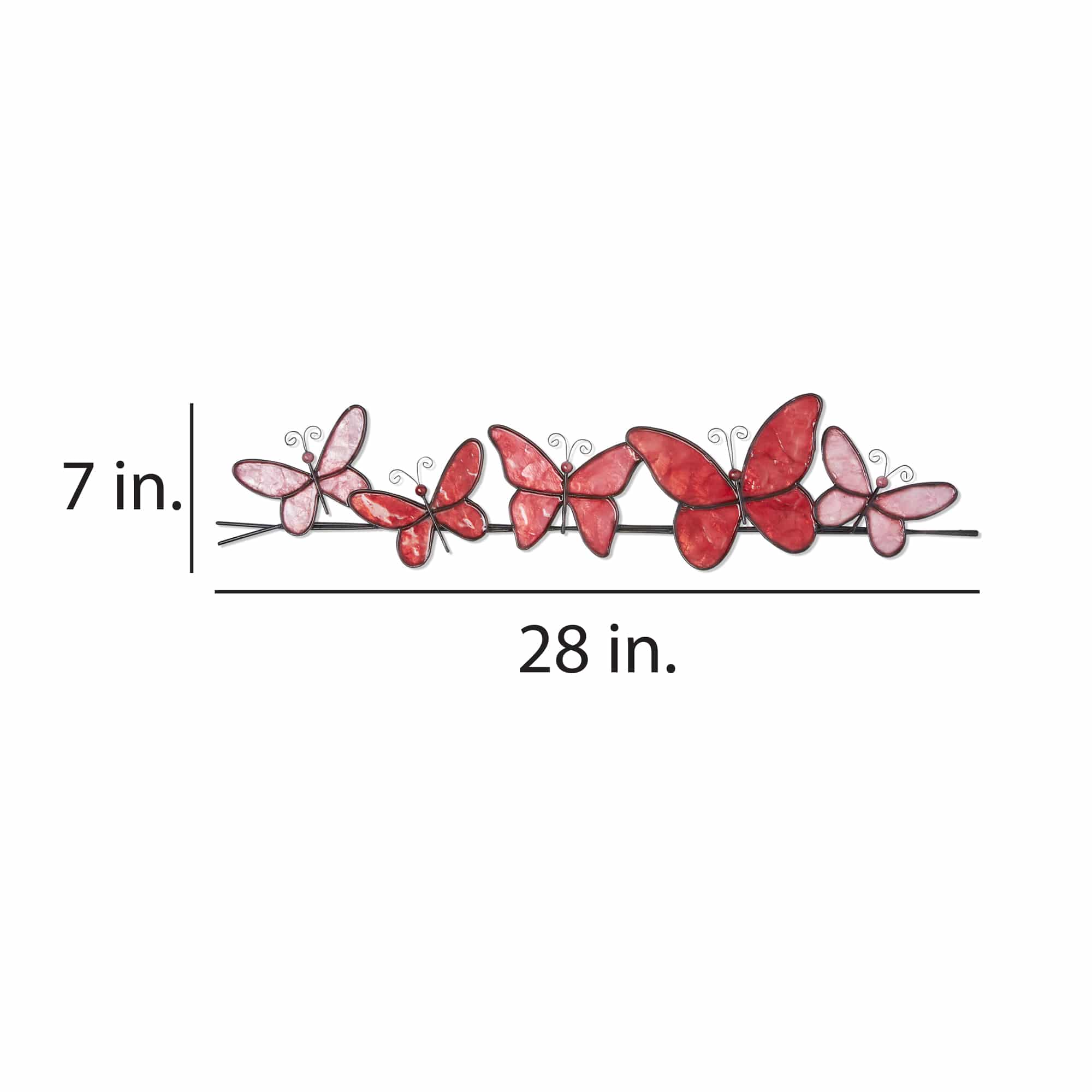
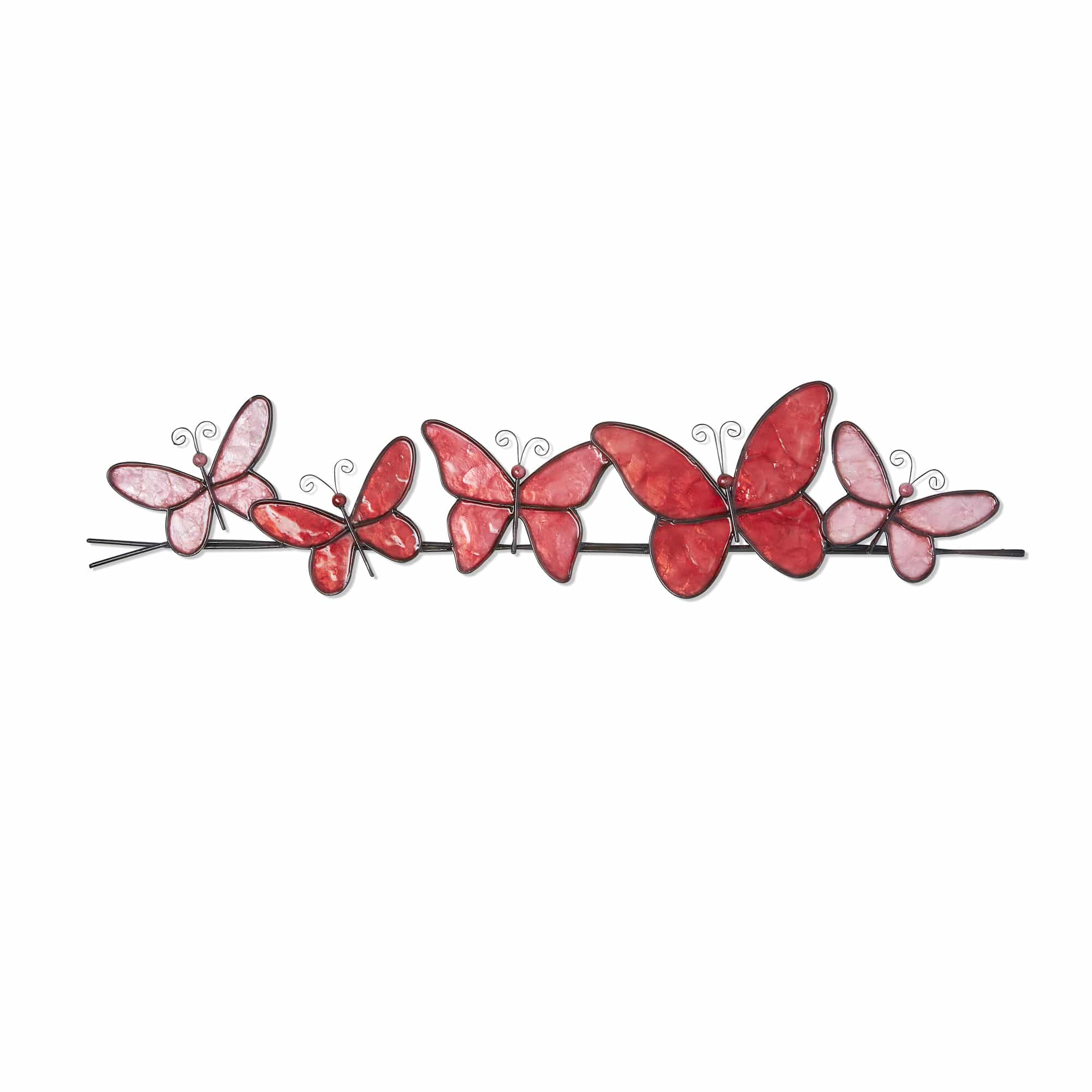
Five, fluttering butterflies are ready to complete their journey after taking a break from a long migration. The slender, metal body of each butterfly connects to colorful capiz-shell wings which catches light and adds shine. Each wing is framed using sturdy wrought iron and reinforced with a metal backing.
The basic frame of the butterfly is created using tin, which is powder-coated with a black finish and makes this piece safe to use outdoors. The edges of the frame are reinforced using thicker tin wire. The front of this piece is adorned in areas with capiz shell, an oyster native to the Philippines, before being hand-painted and sealed with a water-based sealant. The primary purpose of this oyster to provide a source of food, however, the shell is a sustainable by-product that can be used for decoration. The capiz shell subtly replicates the reflective qualities of butterflies in nature. The entire piece is lightweight and has an eyelet in the back allowing it to be hung using a finishing nail, command strip, or a push pin. Due to it being a natural material, the organic colors of capiz come through as tans and browns underneath the paint.
-
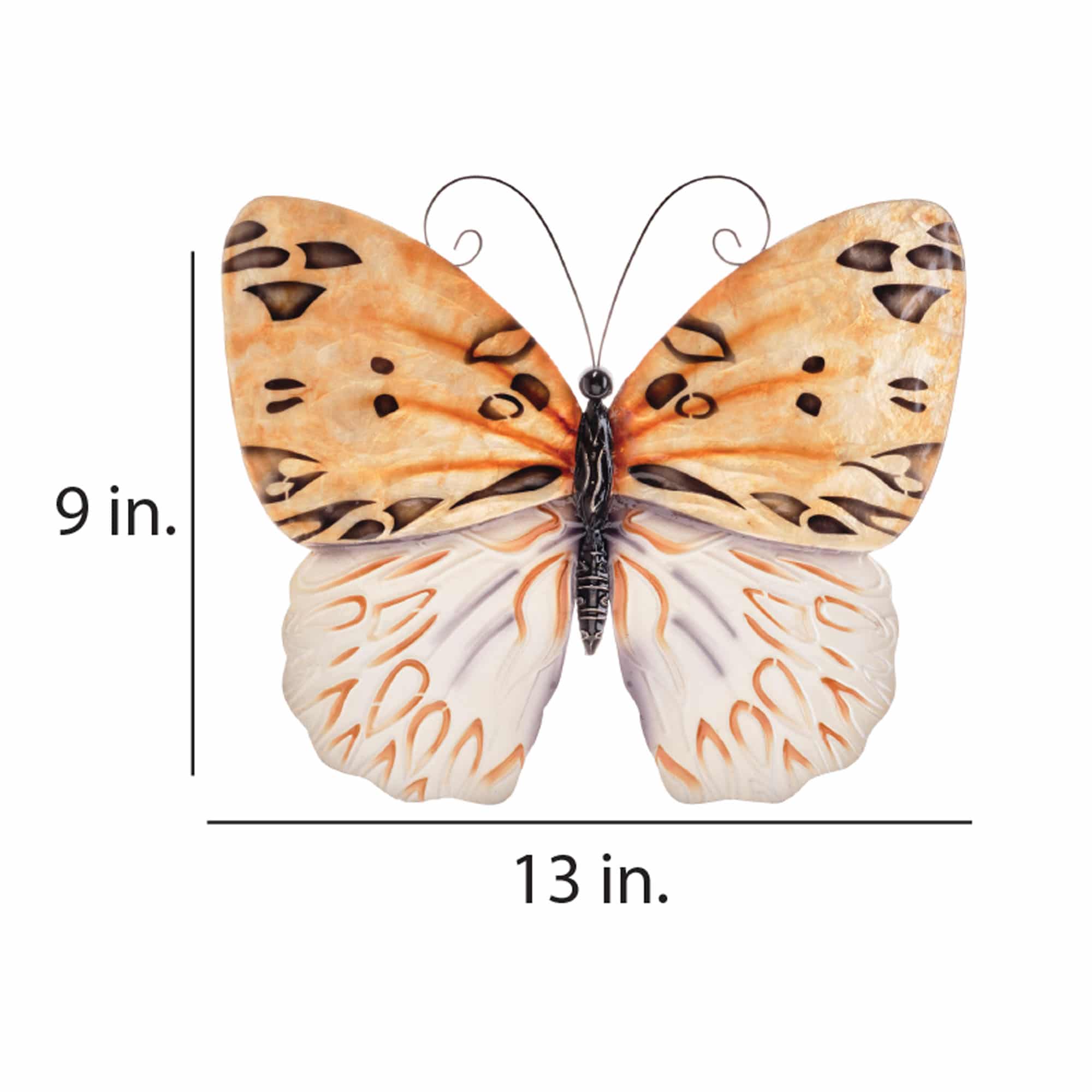
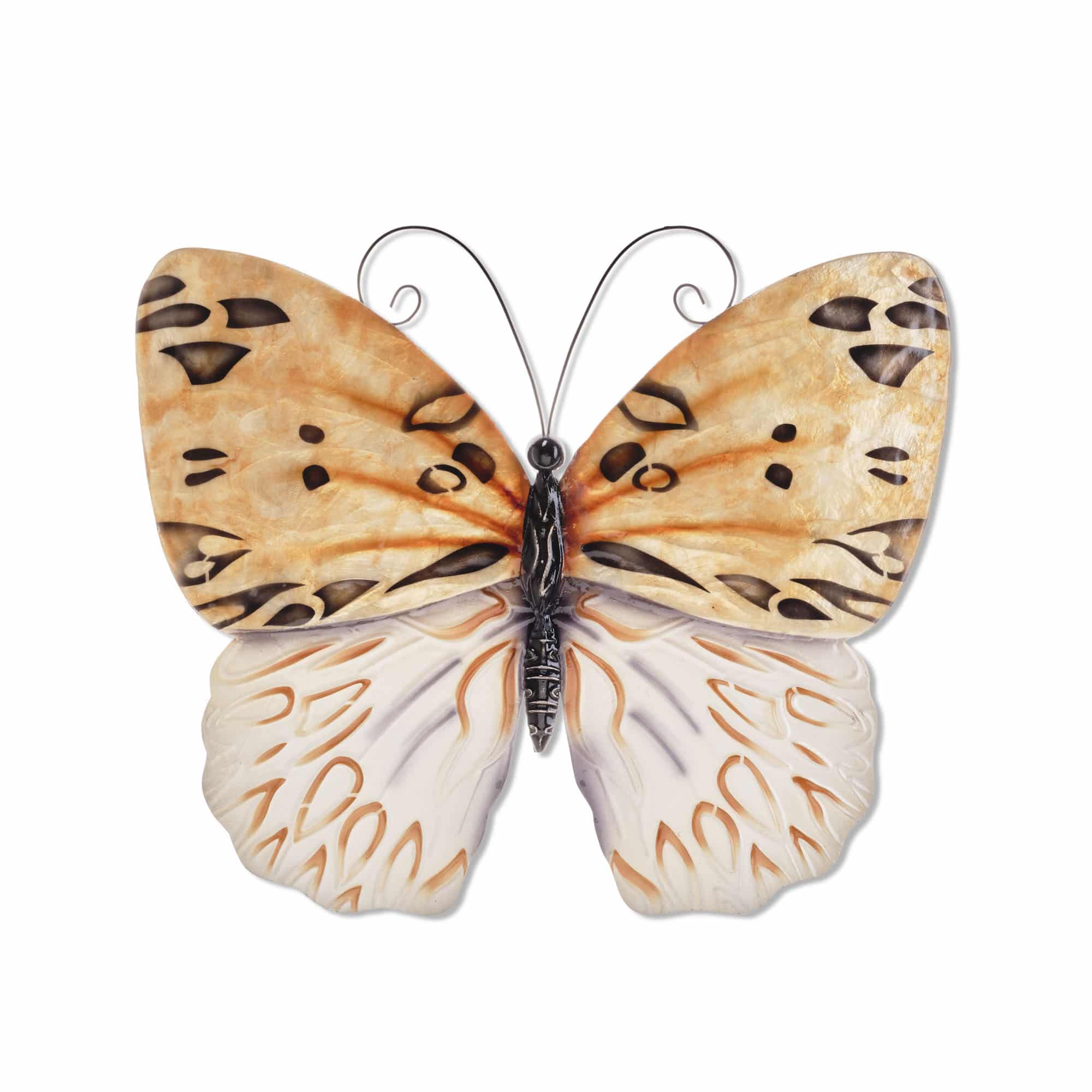
Using paints of various shades and different hues of yellow, this graceful butterfly features an appearance of flowing honey on its upper wings. The lower wings diverge from the honey and are textured in a base white color with highlights of yellow. Stylish and elegant, this piece adds sophistication to the finish of any room, contemporary or traditional.
The basic frame of the butterfly is created using tin, which is powder-coated with a black finish and makes this piece safe to use outdoors. The edges of the frame are reinforced using thicker tin wire. The front of this piece is adorned in areas with capiz shell, an oyster native to the Philippines, before being hand-painted and sealed with a water-based sealant. The primary purpose of this oyster to provide a source of food, however, the shell is a sustainable by-product that can be used for decoration. The capiz shell subtly replicates the reflective qualities of butterflies in nature. The entire piece is lightweight and has an eyelet in the back allowing it to be hung using a finishing nail, command strip, or a push pin. Due to it being a natural material, the organic colors of capiz come through as tans and browns underneath the paint.
-
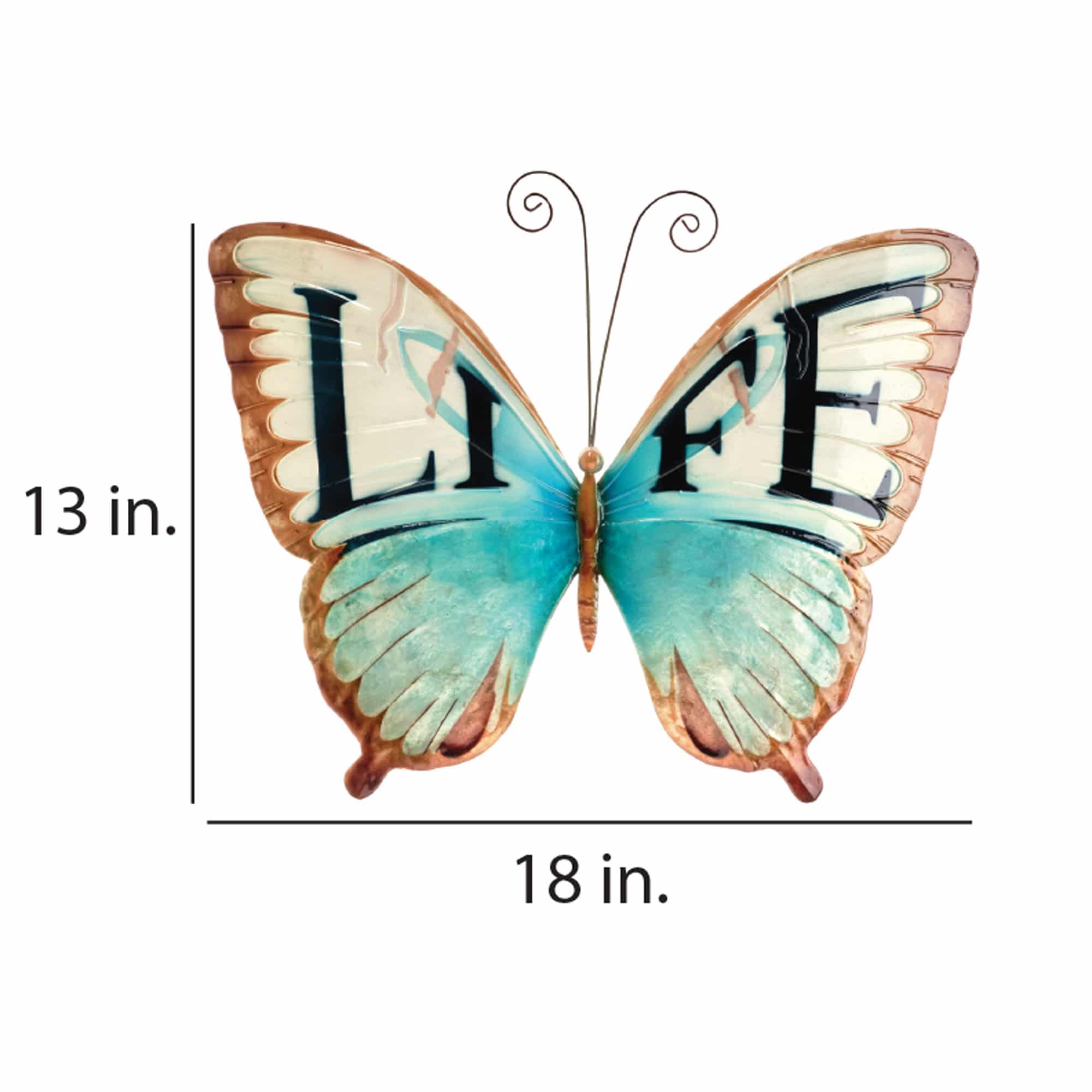
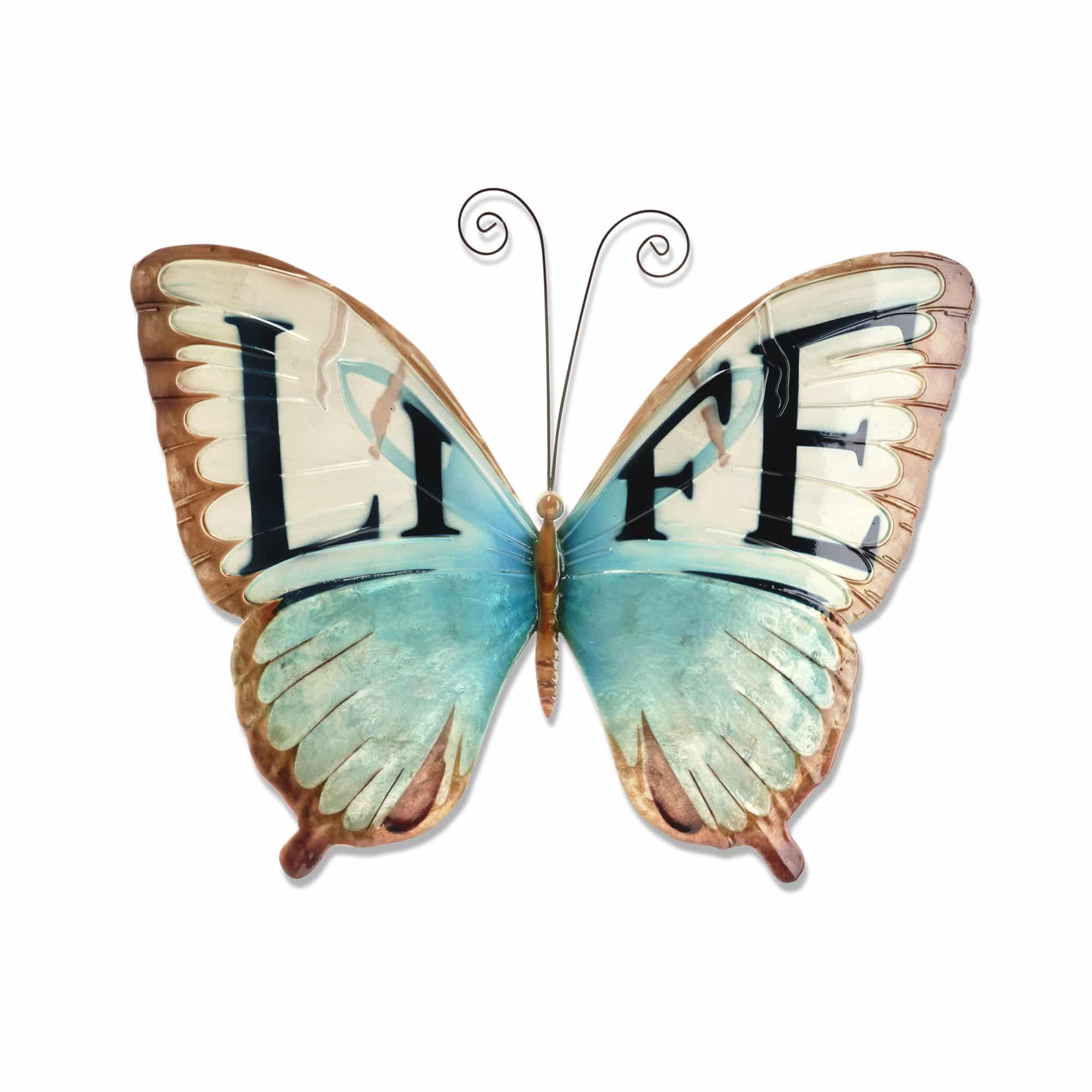
Shedding its cocoon, the butterfly is a strong symbol of rebirth, thus the butterfly is entrenched in many myths and legends around the world about immortality. In many eastern cultures, the color blue also is a symbol of immortality and is used to represent life. As to contrast the subtle meanings behind this butterfly, the word eLife' radiates from the butterfly's very core. This elegant butterfly, highlighted with blue and browns, states clearly that this beautiful creation represents life.
The basic frame of the butterfly is created using tin, which is powder-coated with a black finish and makes this piece safe to use outdoors. The edges of the frame are reinforced using thicker tin wire. The front of this piece is adorned in areas with capiz shell, an oyster native to the Philippines, before being hand-painted and sealed with a water-based sealant. The primary purpose of this oyster to provide a source of food, however, the shell is a sustainable by-product that can be used for decoration. The capiz shell subtly replicates the reflective qualities of butterflies in nature. The entire piece is lightweight and has an eyelet in the back allowing it to be hung using a finishing nail, command strip, or a push pin. Due to it being a natural material, the organic colors of capiz come through as tans and browns underneath the paint.
-
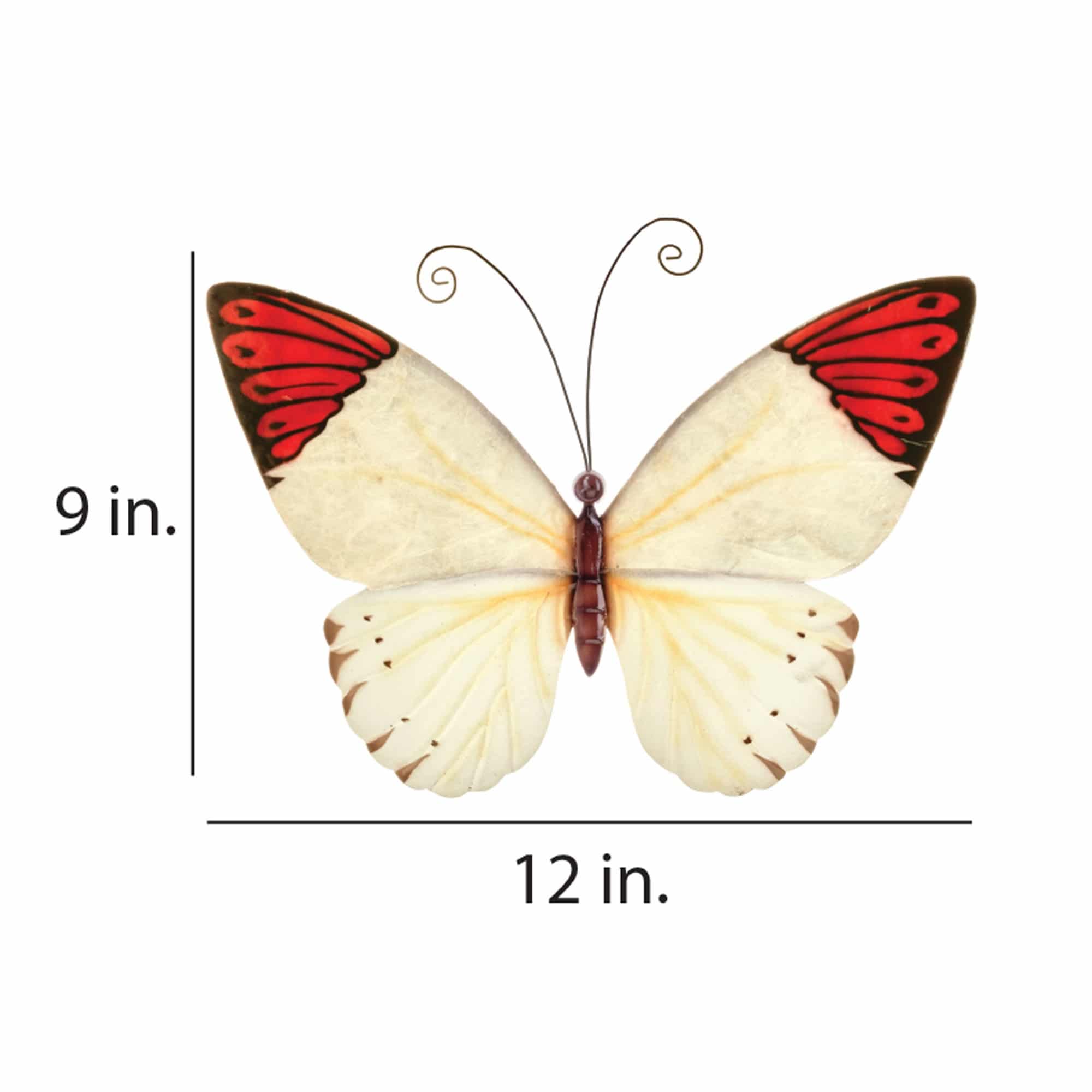
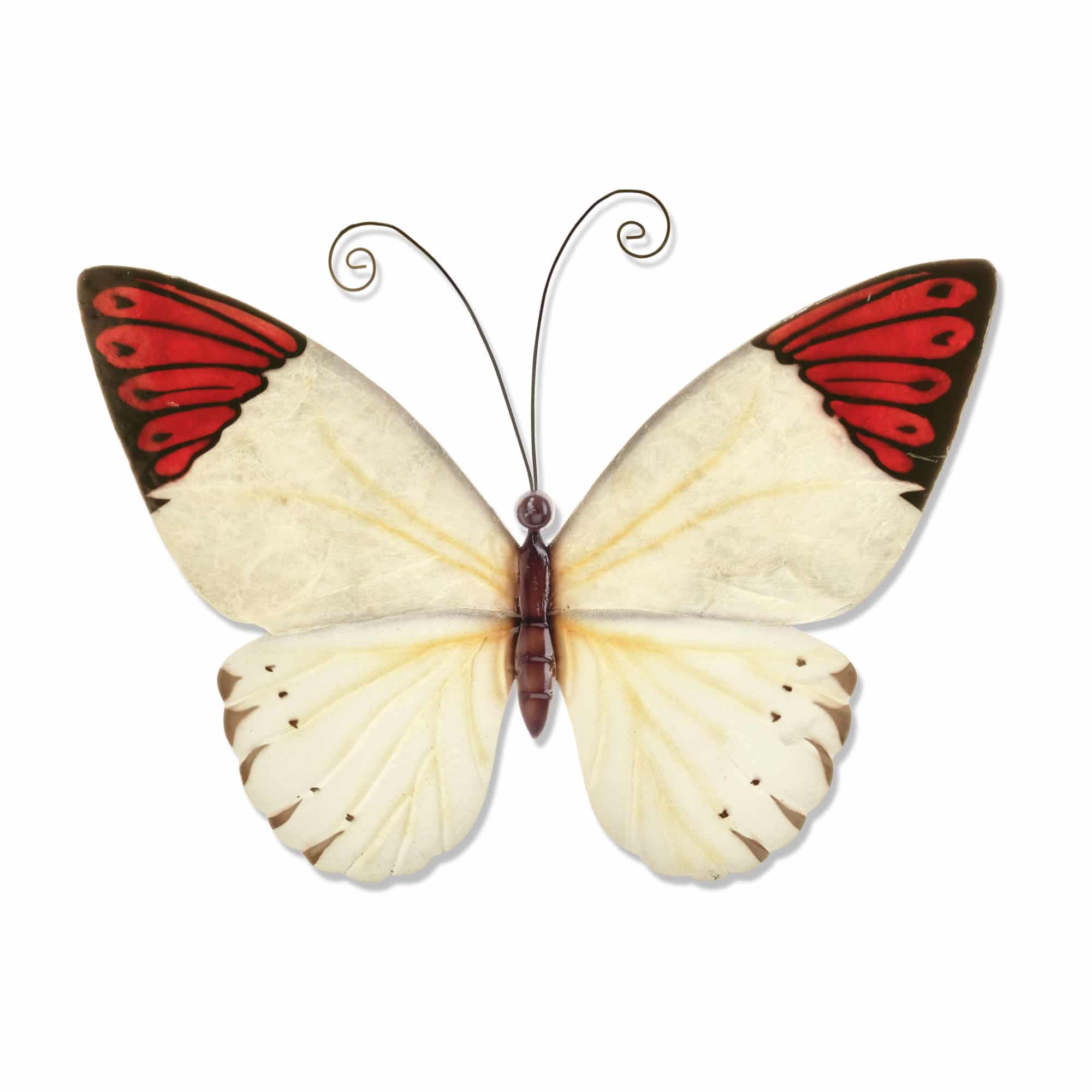 Starting with a base color of pearl white, the artist uses different techniques and splashes of color to craft a distinctive piece. The upper wings are created using capiz oyster shell, left natural to bring in different natural hues. The red base color is accented using brown feathering patterns. The lower portion of the wing is made of tin, textured to highlight the lines that stem from the body of the butterfly. The basic frame of the butterfly is created using tin, which is powder-coated with a black finish and makes this piece safe to use outdoors. The edges of the frame are reinforced using thicker tin wire. The front of this piece is adorned in areas with capiz shell, an oyster native to the Philippines, before being hand-painted and sealed with a water-based sealant. The primary purpose of this oyster to provide a source of food, however, the shell is a sustainable by-product that can be used for decoration. The capiz shell subtly replicates the reflective qualities of butterflies in nature. The entire piece is lightweight and has an eyelet in the back allowing it to be hung using a finishing nail, command strip, or a push pin. Due to it being a natural material, the organic colors of capiz come through as tans and browns underneath the paint.
Starting with a base color of pearl white, the artist uses different techniques and splashes of color to craft a distinctive piece. The upper wings are created using capiz oyster shell, left natural to bring in different natural hues. The red base color is accented using brown feathering patterns. The lower portion of the wing is made of tin, textured to highlight the lines that stem from the body of the butterfly. The basic frame of the butterfly is created using tin, which is powder-coated with a black finish and makes this piece safe to use outdoors. The edges of the frame are reinforced using thicker tin wire. The front of this piece is adorned in areas with capiz shell, an oyster native to the Philippines, before being hand-painted and sealed with a water-based sealant. The primary purpose of this oyster to provide a source of food, however, the shell is a sustainable by-product that can be used for decoration. The capiz shell subtly replicates the reflective qualities of butterflies in nature. The entire piece is lightweight and has an eyelet in the back allowing it to be hung using a finishing nail, command strip, or a push pin. Due to it being a natural material, the organic colors of capiz come through as tans and browns underneath the paint. -

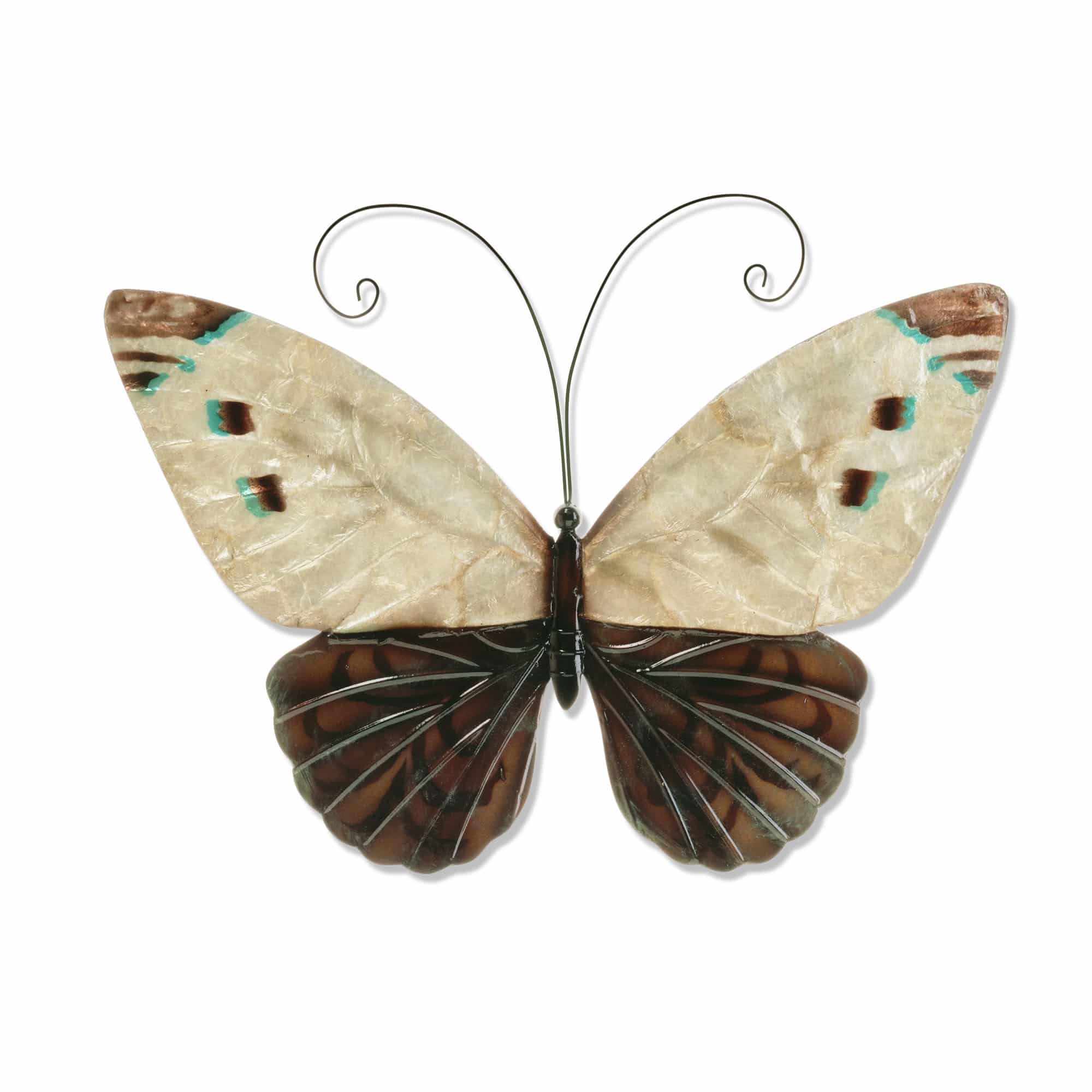
The wings of this butterfly are divided into two parts. Soft muted organic colors are hand-painted onto mother of pearl oyster shells on the upper portion of the wings. The lower portion of the wings contrast with bold lines etched into the tin base. That is then hand-painted using a dark brown with a gloss finish reflecting different shades of color changing with the light.
The basic frame of the butterfly is created using tin, which is powder-coated with a black finish and makes this piece safe to use outdoors. The edges of the frame are reinforced using thicker tin wire. The front of this piece is adorned in areas with capiz shell, an oyster native to the Philippines, before being hand-painted and sealed with a water-based sealant. The primary purpose of this oyster to provide a source of food, however, the shell is a sustainable by-product that can be used for decoration. The capiz shell subtly replicates the reflective qualities of butterflies in nature. The entire piece is lightweight and has an eyelet in the back allowing it to be hung using a finishing nail, command strip, or a push pin. Due to it being a natural material, the organic colors of capiz come through as tans and browns underneath the paint.
-


Classically painted roses adorn this set of three butterflies. The traditional pattern brings the garden indoors. Painted on mother of pearl oyster shells, the vibrant roses pop, adding color and charm.
The basic frame of the butterfly is created using tin, which is powder-coated with a black finish and makes this piece safe to use outdoors. The edges of the frame are reinforced using thicker tin wire. The front of this piece is adorned in areas with capiz shell, an oyster native to the Philippines, before being hand-painted and sealed with a water-based sealant. The primary purpose of this oyster to provide a source of food, however, the shell is a sustainable by-product that can be used for decoration. The capiz shell subtly replicates the reflective qualities of butterflies in nature. The entire piece is lightweight and has an eyelet in the back allowing it to be hung using a finishing nail, command strip, or a push pin. Due to it being a natural material, the organic colors of capiz come through as tans and browns underneath the paint.



